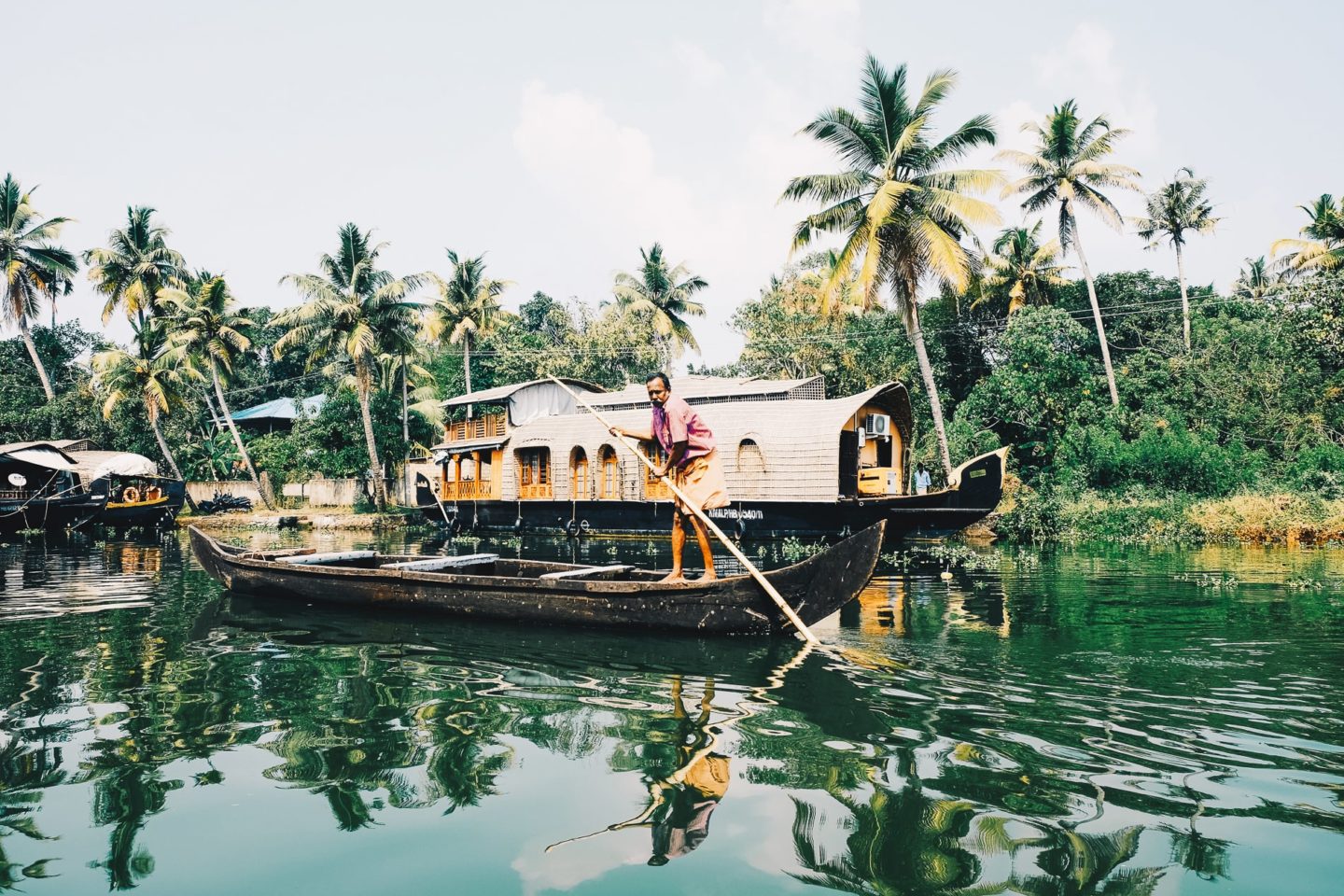
Kerala, a region of India apart, almost another country after all. At the same time, with a country of 1.23 billion inhabitants, comprising more than 25 states, and home to 3,000 dialects, 27 of which are officially recognized, how can it be otherwise?
Kerala, whose name means “land of coconut palms” in Malayalam, is so green that the English made it their favorite holiday resort. And it’s true that I’ve never seen so many! A verdant region with 8 months of sunshine a year, where you can let yourself be carried away by house boats gliding along the many canals (the famous backwaters) leading to fishing villages, themselves surrounded by coconut groves and rice paddies. Kerala is a mountainous region covered with coffee and tea trees and a land rich in aromatic plants.
Kerala is all about tropical charm and generous nature, where you can do so much in 15 days. A varied journey through beaches, spices, jungle, waterfalls, wildlife and tea and coffee plantations. Kerala also rhymes with relaxation, being the cradle of ayurveda, traditional Indian medicine! It’s a perfect vacation and wellness destination with a unique character that will enchant you for your first time in India. In my opinion, it’s the most affordable region of this great, bewitching country. A state that lives up to its nickname of “God’s Own Country” (God’s own country).
The differences between Rajasthan and Kerala are many and marked: the friendliness and warmth of the people, the diverse landscapes, the milder temperatures and the delicious food. With over 34 million inhabitants, Kerala is one of India’s richest states. Keralans enjoy a better quality of life, with one of the highest life expectancy rates in the world, and have access to levels of healthcare and education almost comparable to some Western countries. it’s also probably the cleanest region in the country overall, and the one where poverty is least visible. Finally, what also impressed me was the rather harmonious cohabitation of different religions. Indeed, believers are very tolerant of each other, and in the same town you can find a Hindu temple, a mosque, a church or even a synagogue.
Our journey begins in Cochin and will take you to Mysore in Karnataka, passing through Madurai in Tamil Nadu. We’re going to introduce you to 3 departments in South India.
I invite you to read all our other articles on Kerala to help you prepare for your trip:
- How to soothe your body with ayurveda
- Our tasty and spicy Indian recipes
- The 9 spices of Indian cuisine
- The practical guide to planning your trip
WHAT TO DO & WHAT TO SEE IN KERALA | OUR 15-DAY TOUR GUIDES
_____________________________________________
SOMMAIRE DE L'ARTICLE :
| COCHIN
The first thing we noticed on arriving at Cochin airport in Kerala was the long skirt called longhi worn by the men, in stark contrast to Rajasthani men’s outfits. Cochin (Kochi) is a lively city, also punctuated by the Rickshaw, the famous local tuk tuk, but also a port, which lives to the rhythm of the shipments of goods and in particular spices produced in Kerala. The town also boasts a fishing port and a fishing area called “Chinese fishing nets” (large fishermen’s nets), which are great fun to visit on foot. You’ll see the locals haggling for fish in the early morning and at sunset. An opportunity to exercise your arms by taking part in a net-raising exercise with the fishermen. It’s a place you’ll love because it’s so photogenic.
The city is just like Kerala, with its diversity of style and ambience, and it’s a great place to live! The cohabitation of Hinduism, Jainism, Islam, Christianity and Judaism has gone remarkably well for centuries. A past that can be seen at the turn of every street or monument. Fort Cochin is the most touristic and ancient part of the city, which bears witness to an interesting colonial past: Portuguese, Spanish, Dutch, English, French came here over the last centuries, in search of the famous spices. The city is packed with colorful churches, such as Francis Church, India’s first Christian church, as well as a synagogue that bears witness to the city’s Jewish past (although only one elderly member of this denomination remains), and, of course, Hindu temples. So take the time to visit essentially Fort Cochin to observe all this and the goods traffic in its old streets.
Cochin is also a place where you can see spices like ginger drying in the sun before being shipped abroad in large burlap sacks.
Thirsty in this heat? Head to Princess Street in the Jewish Quarter, home to many of the city’s coffee shops. Indulge in a Lassi, a popular yoghurt-based drink flavored with banana or ginger. There are plain, sweet and savoury ones, a real treat and super thirst-quenching! Taste the coconut juice and sugarcane juice available from the street markets. If you’d like a beer, please note that it’s forbidden to drink alcohol on the terraces (it mustn’t be visible). The Keralites will serve you alcohol in a teapot with cups so as not to attract attention!
At the end of the day, you can also visit the kathakali. This is a lengthy Kerala dance and mime show, explaining the universal struggle between good and evil. The actors play out an act from a local story where the most interesting part is the preparation. You’ll be able to see the actors’ magnificent on-stage make-up, as well as their very difficult stage performance. It’s interesting to watch, but hard to understand.
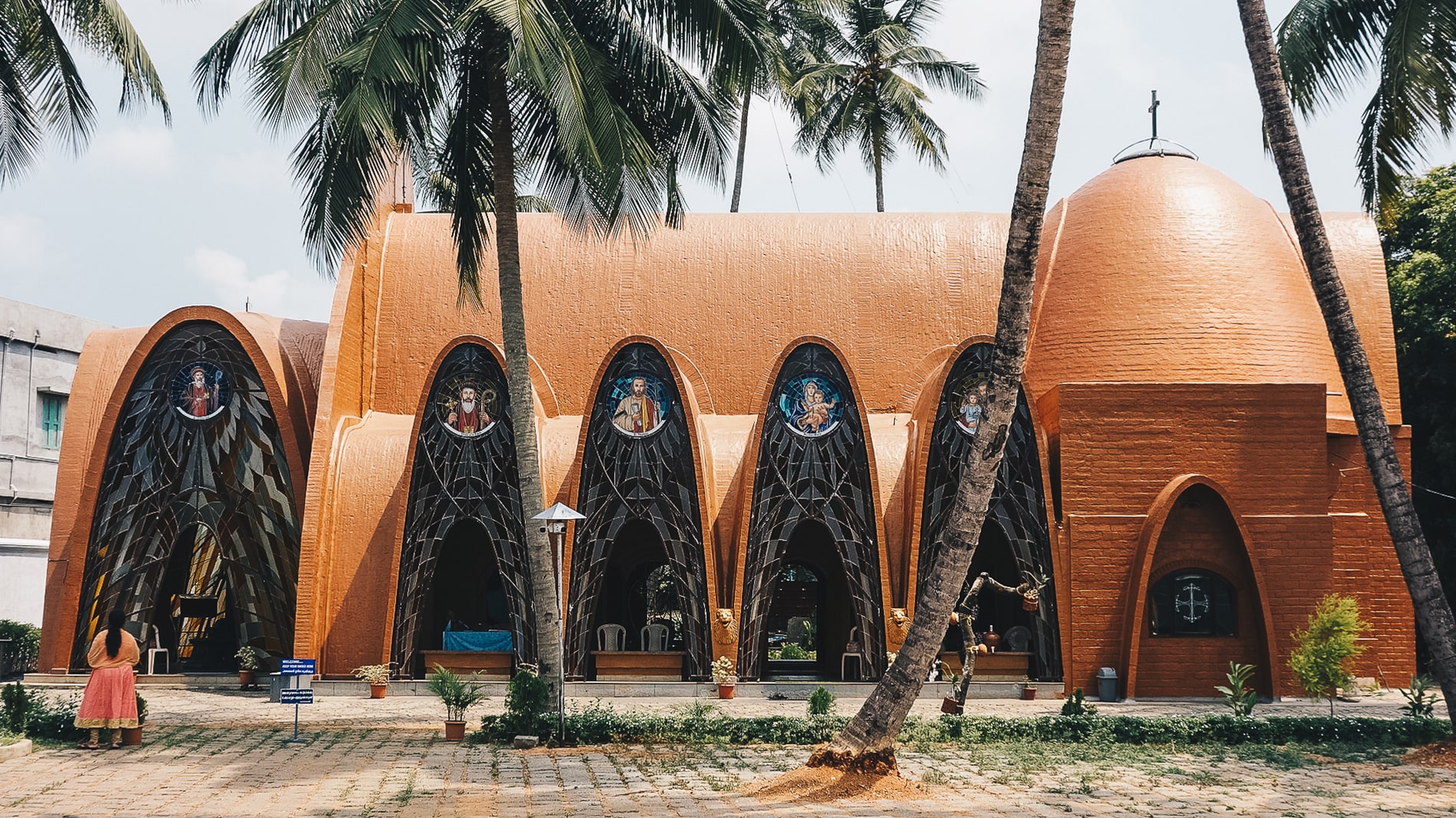
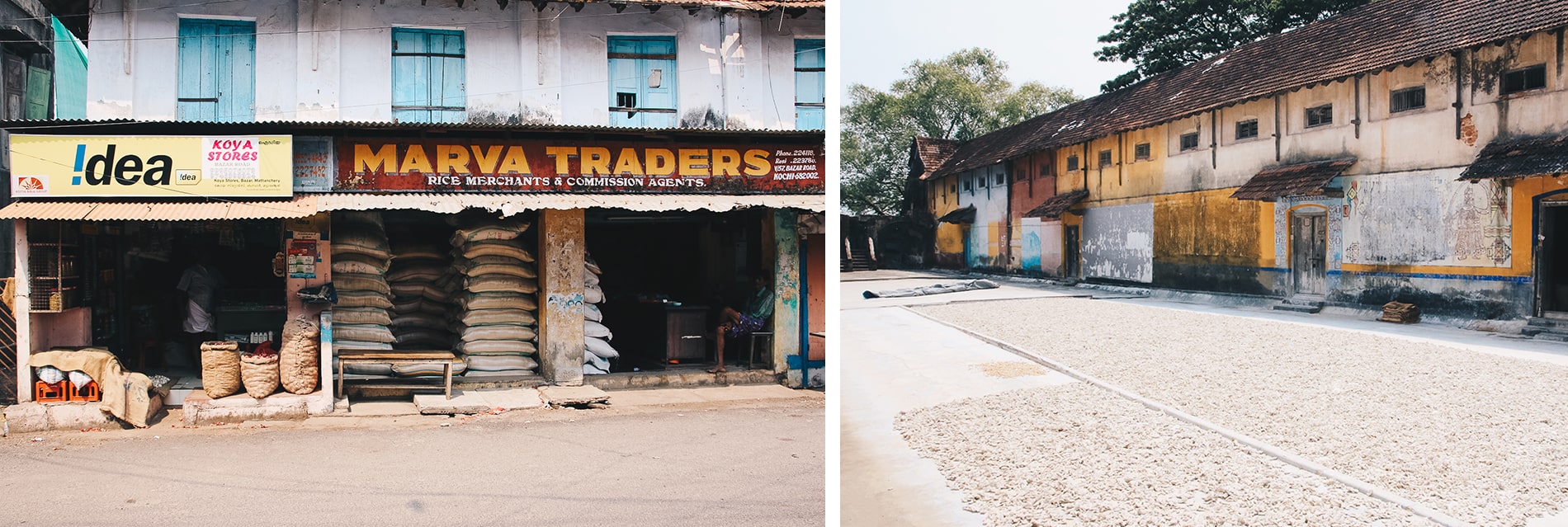
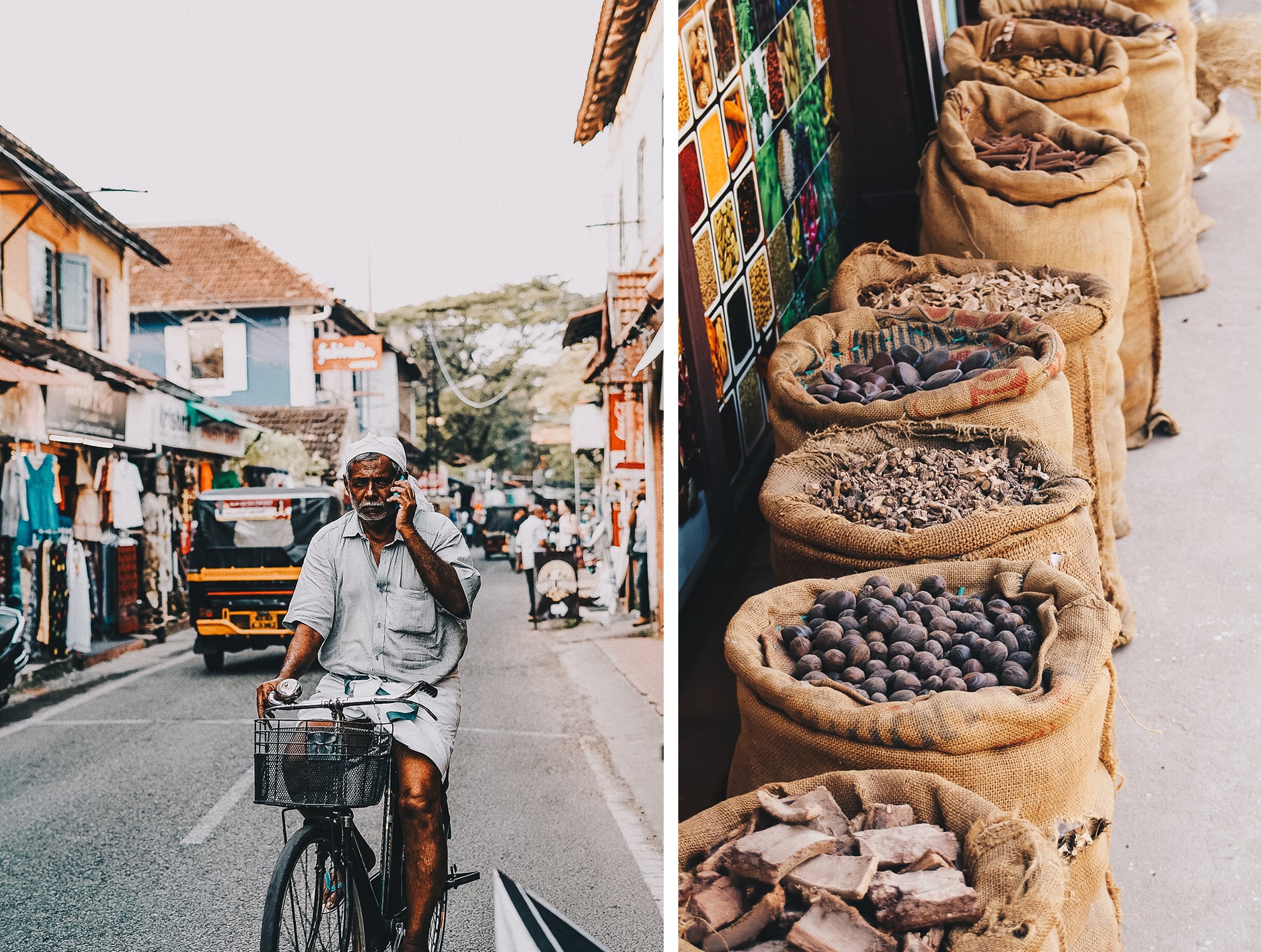
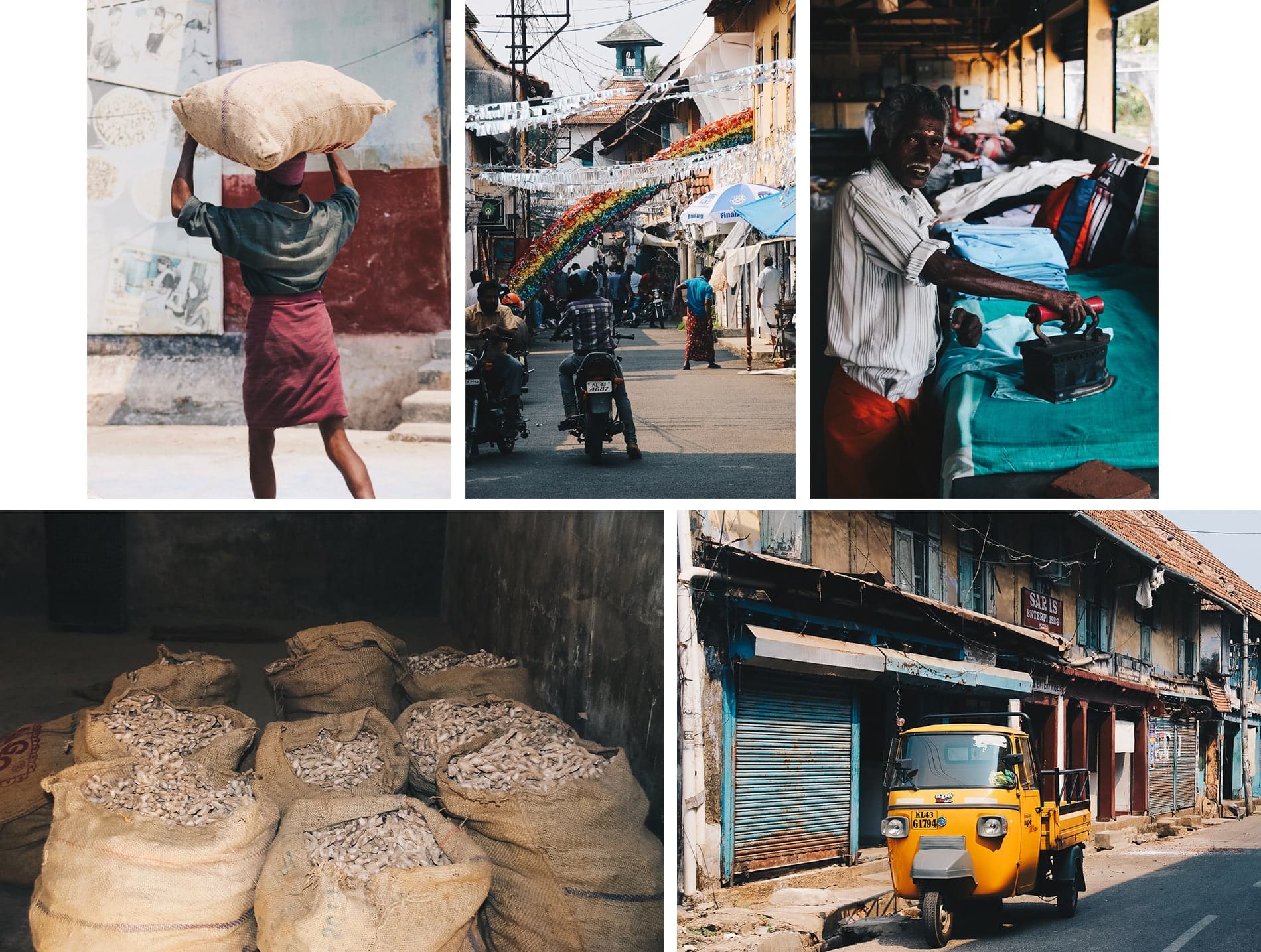
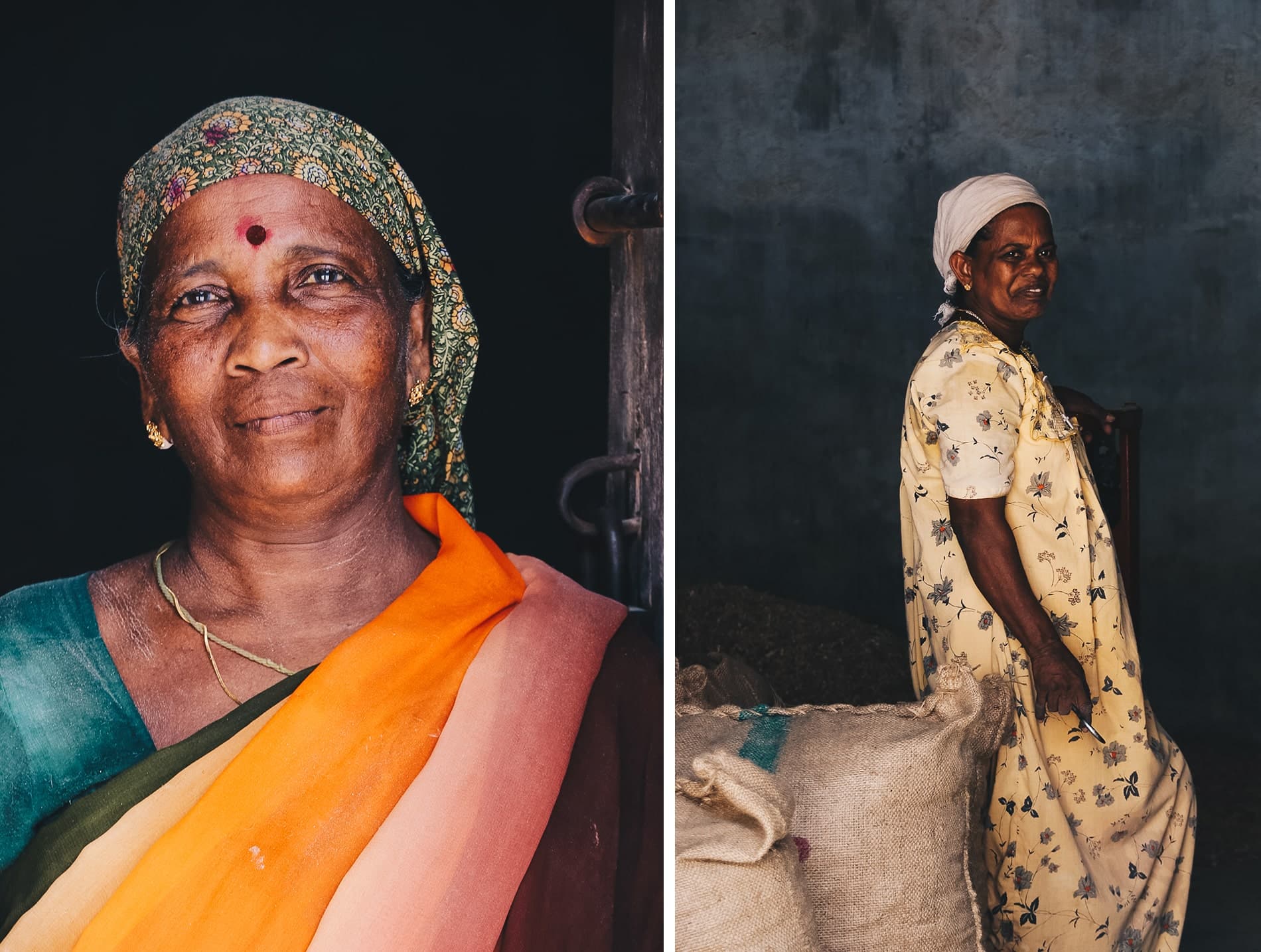
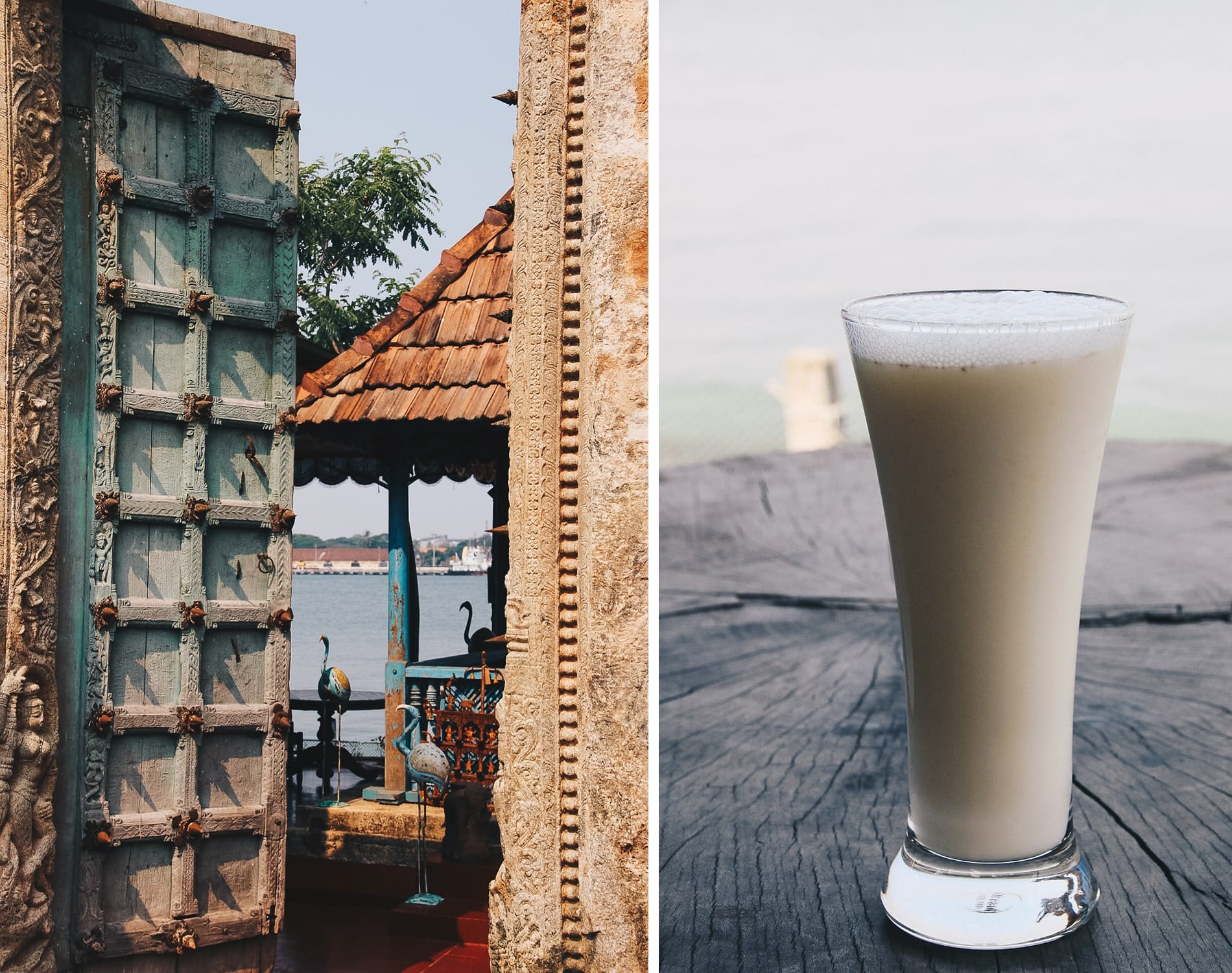
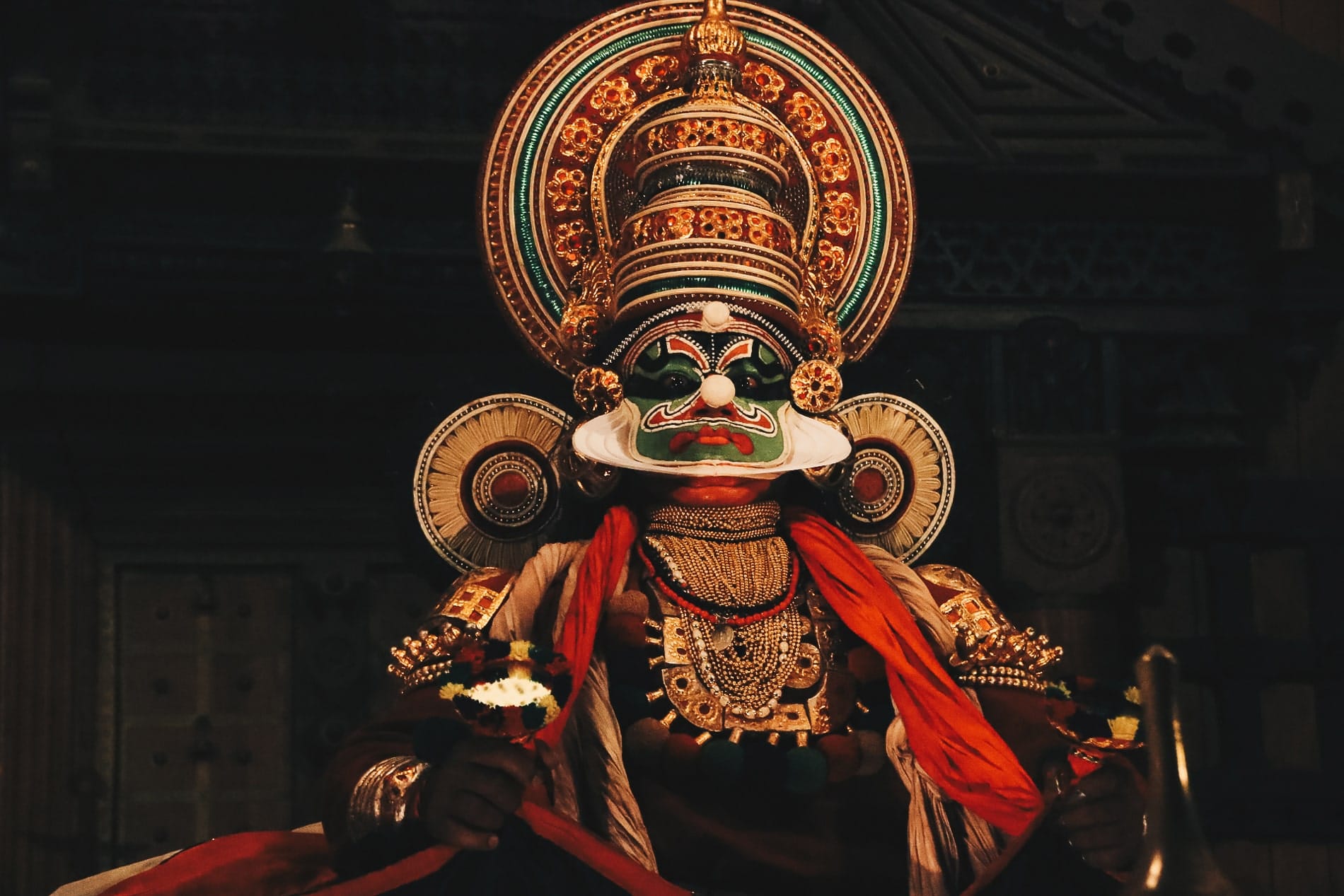
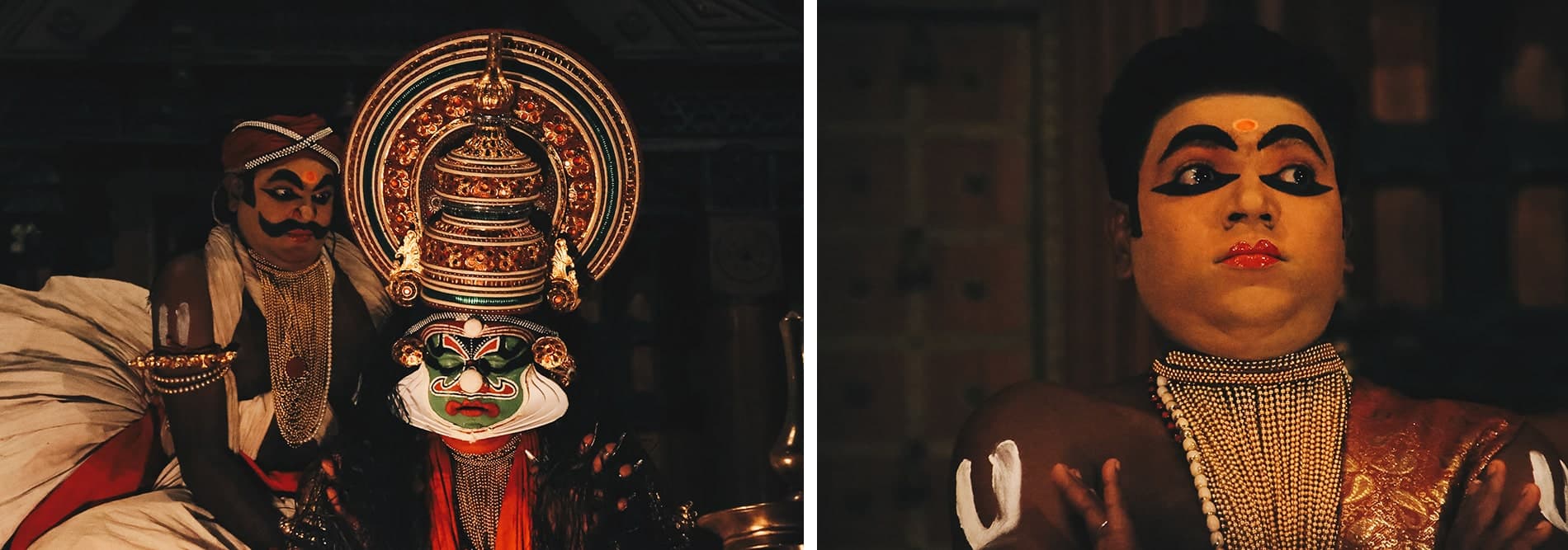
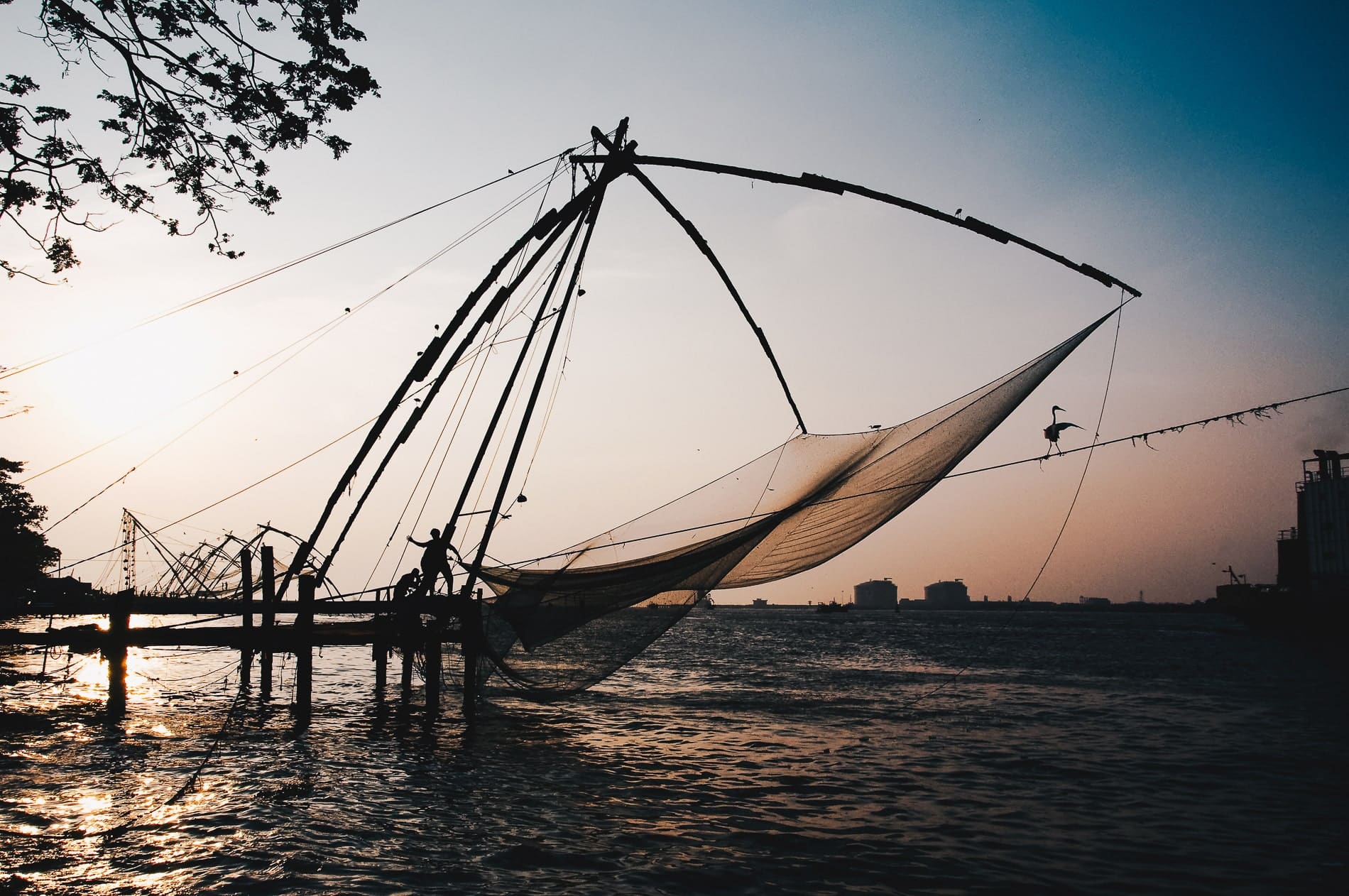
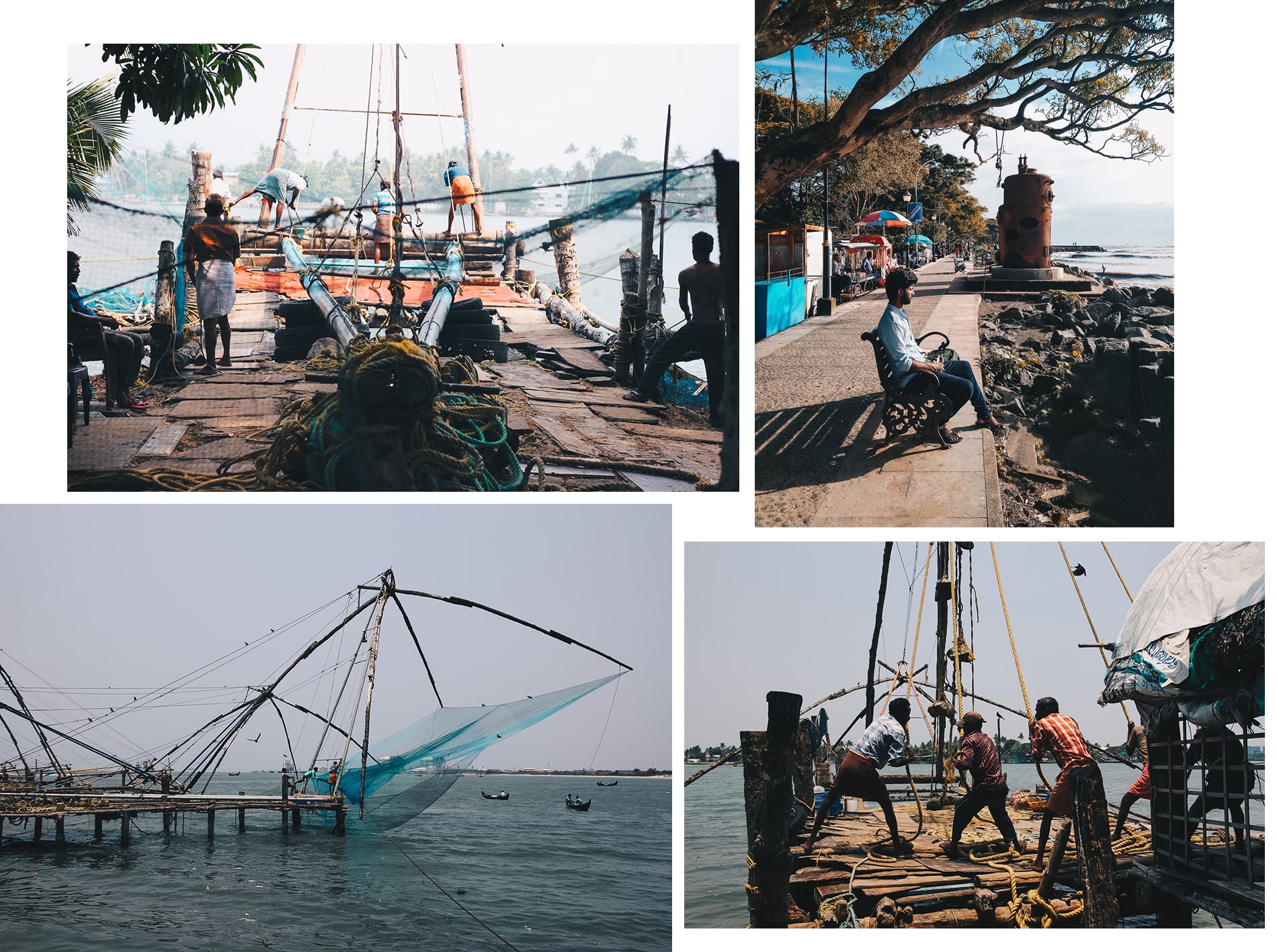
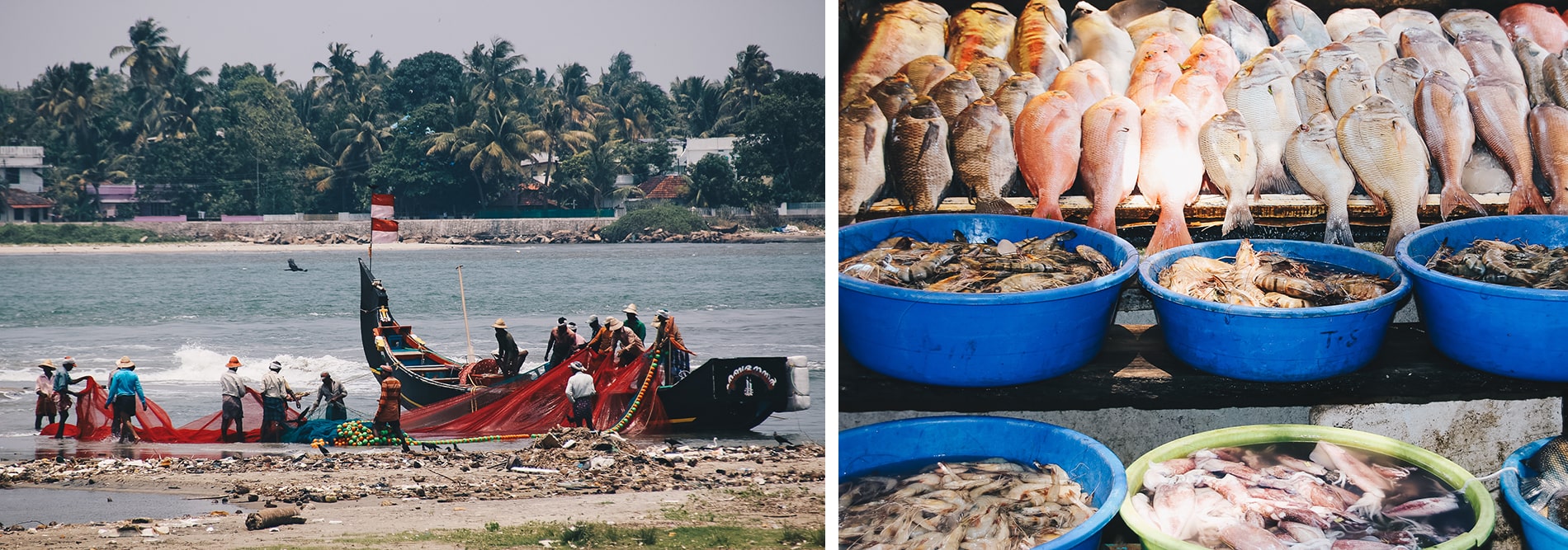
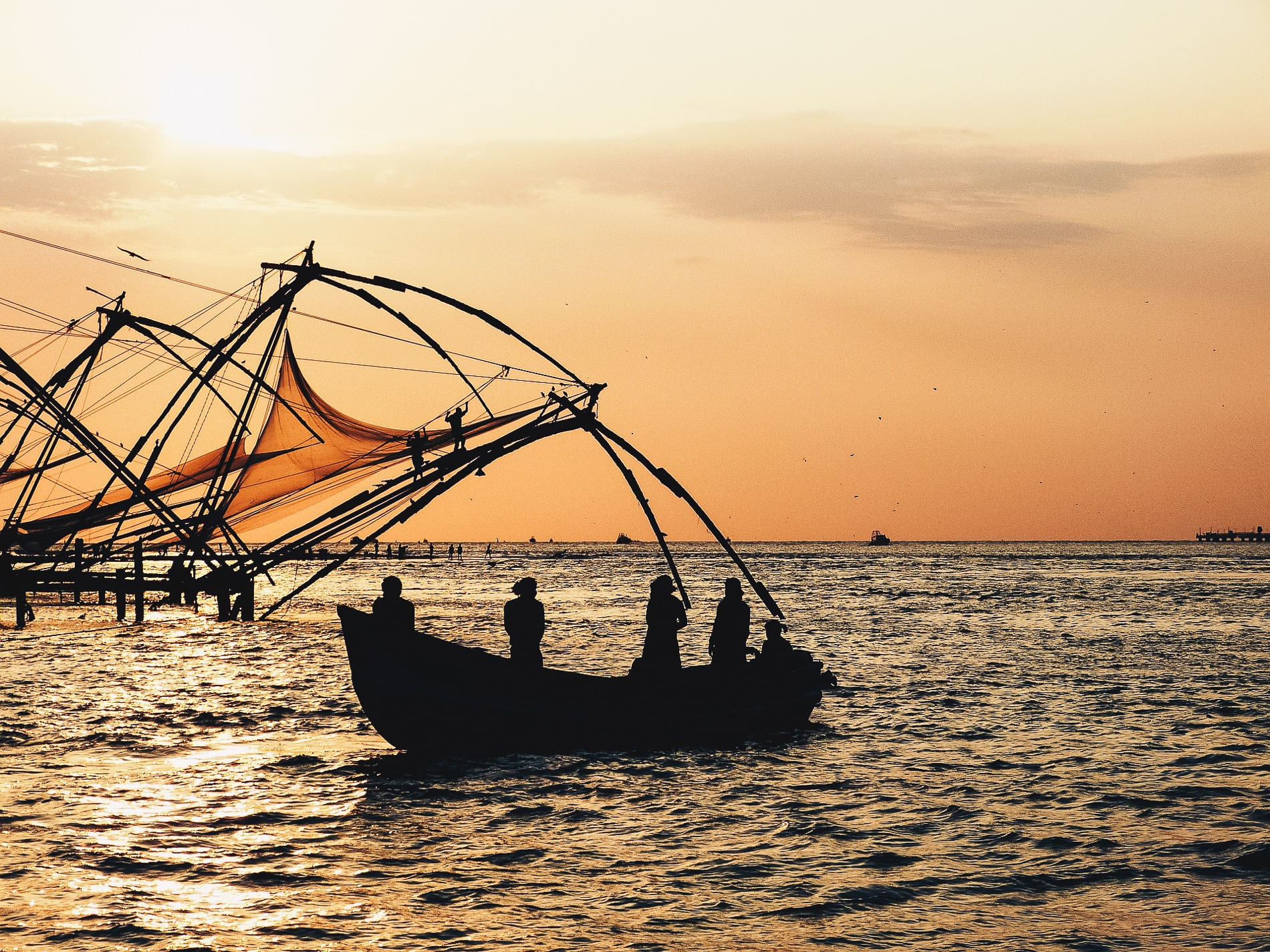
| Where to sleep in Fort Cochin?
If, like us, you love charming hotels, here’s our selection of favorites:
➡️ If you haven’t found what you’re looking for, we invite you to see the best offers and book on booking .
| Where to eat and have a coffee/lassi?
- Teapot coffee (Peter Celli St, Fort Kochi)
- Rasoi Fort Kochi (Rose Street Next to St Francis Church)
- Sutra Restaurant (1/334 Rose Street Fort Cochin)
- Alice délice French bakery (Door # Cc1 339 Fort Nagar Rose Street )
- Kashi (Burgher Street Fort Kochi)
- Qissa Cafe (18 K B Jacob Road No. 18 Hotel, Near Fort Kochi)
- Pepper House coffee (Pepper House, Kalvatty Road Fort Cochin)
- Kashi art coffee (Burgher Street Fort Kochi)
- Chilliout Cafe Cherai beach (Munambam Rd, Cherai Beach, Cochin)
| Activities at Cochin
- For food lovers, we invite you to the restaurant “Casa Linda” for a cooking class and a discovery of the pleasures of local cuisine as we love them. We had a great time with this charming couple.
- The Kathakali dance show.
- City tour by bike with local guide.
- Shopping in the Jewish Quarter or near Fort Cochin Square.
| ALLEPPEY
We continue our journey to the backwaters of Alleppey, a 1h30 drive from Cochin. The backwaters are, quite simply, the vast ecosystem-rich networks of canals and rivers that run through the western part of the state. There are several ways to discover the backwaters: taking, for example, a houseboat and sleep 1 night on board or sail on a smaller, more authentic boat, which allows you to enter the small inner canals. But it’s also possible to explore the canals by canoe (much less expensive) or along the banks by bike, and of course on foot.
Today, there are more respectful alternatives to appreciate this unique landscape. In fact, you can travel by pirogue and stay in a small, charming accommodation with just a few rooms. The program includes massages, boat rides and quality meals. A formula that will appeal to slow-tourists.
Alleppey nicknamed the “Indian Venice” is also an opportunity to be pampered during a mini cruise aboard a houseboat, the famous “houseboats” that cruise the main canal for an afternoon and a night. Originally the “Kettuvalam” (the houseboat’s real name) was used to transport goods such as spices and rice. Today, it is only used for travelers, and features 2 to 4 bedrooms with dining room, terrace and kitchen in a colonial style.
These houseboats are a great way to take your time and relax peacefully, if you do so in low season. One of the big drawbacks is that you won’t be able to slip into the small inner canals because they’re far too big and polluting! At the height of the tourist season, a parade of boats awaits you, causing traffic jams. And yes, Kerala is world-famous for its lush canals.
We really fell under the spell of the backwaters, but if we had to help you make your choice, we preferred the small boat that takes you into the heart of the backwaters. Along the way, we discover beautiful scenes of life, meet local people and take the time to appreciate each moment, each place – it’s so beautiful and so peaceful! When the sun sets, these moments are even more intense, as the sun shines through the many coconut palms and the magic happens. The rice paddies surrounding the canals create a magical backdrop, and we were enchanted by the smiles of the people who greeted us on the banks as we cruised the canals in the sunset light. A stage not to be missed
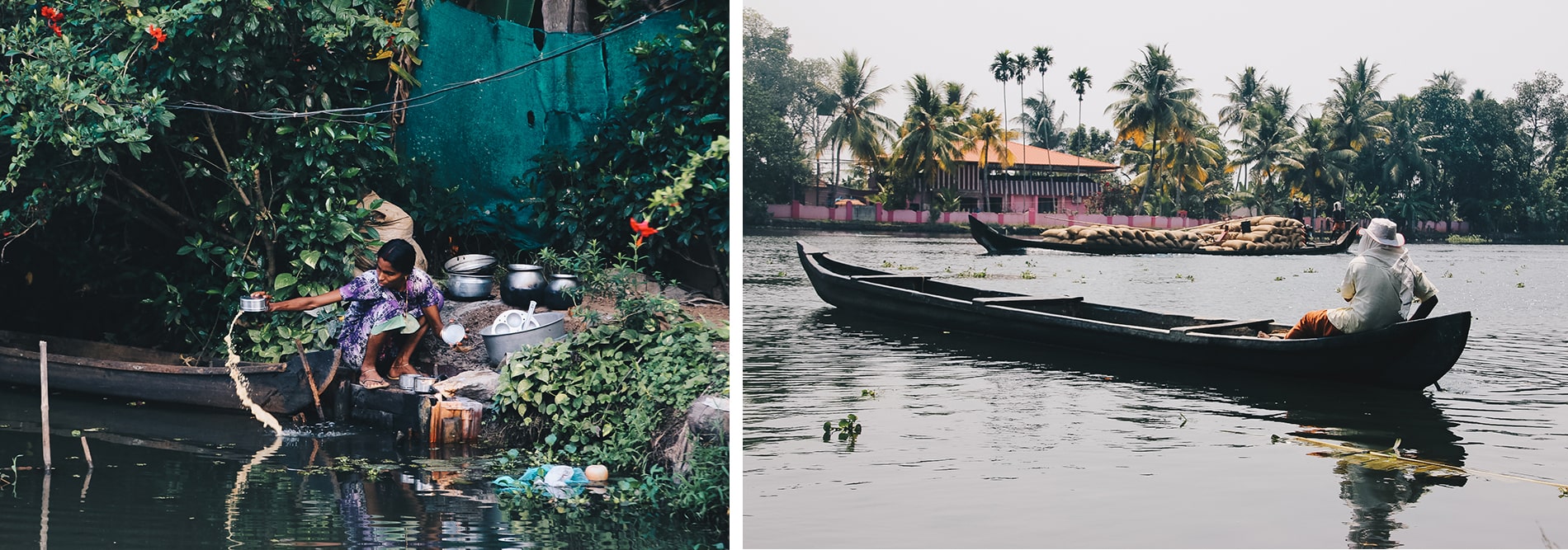
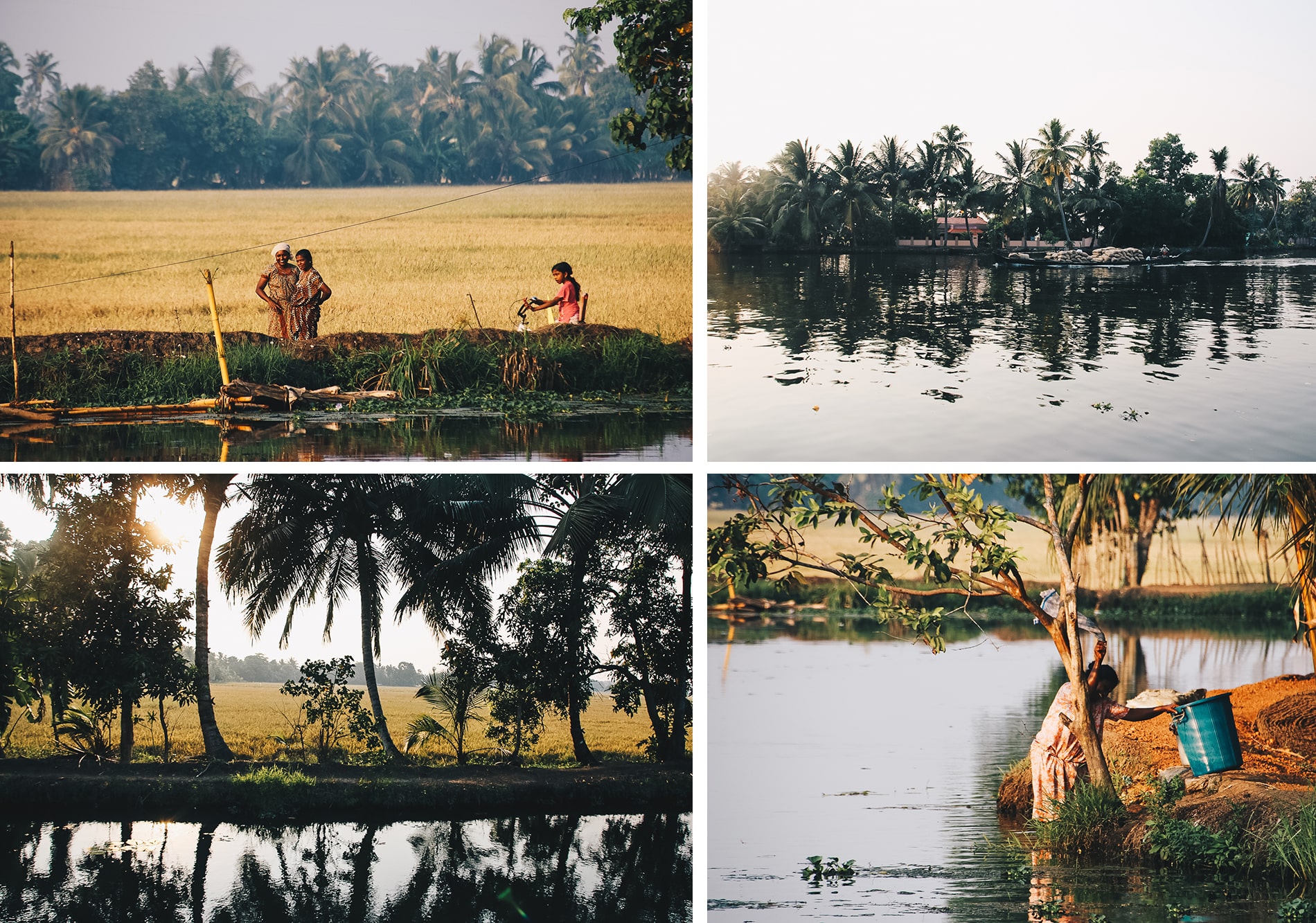
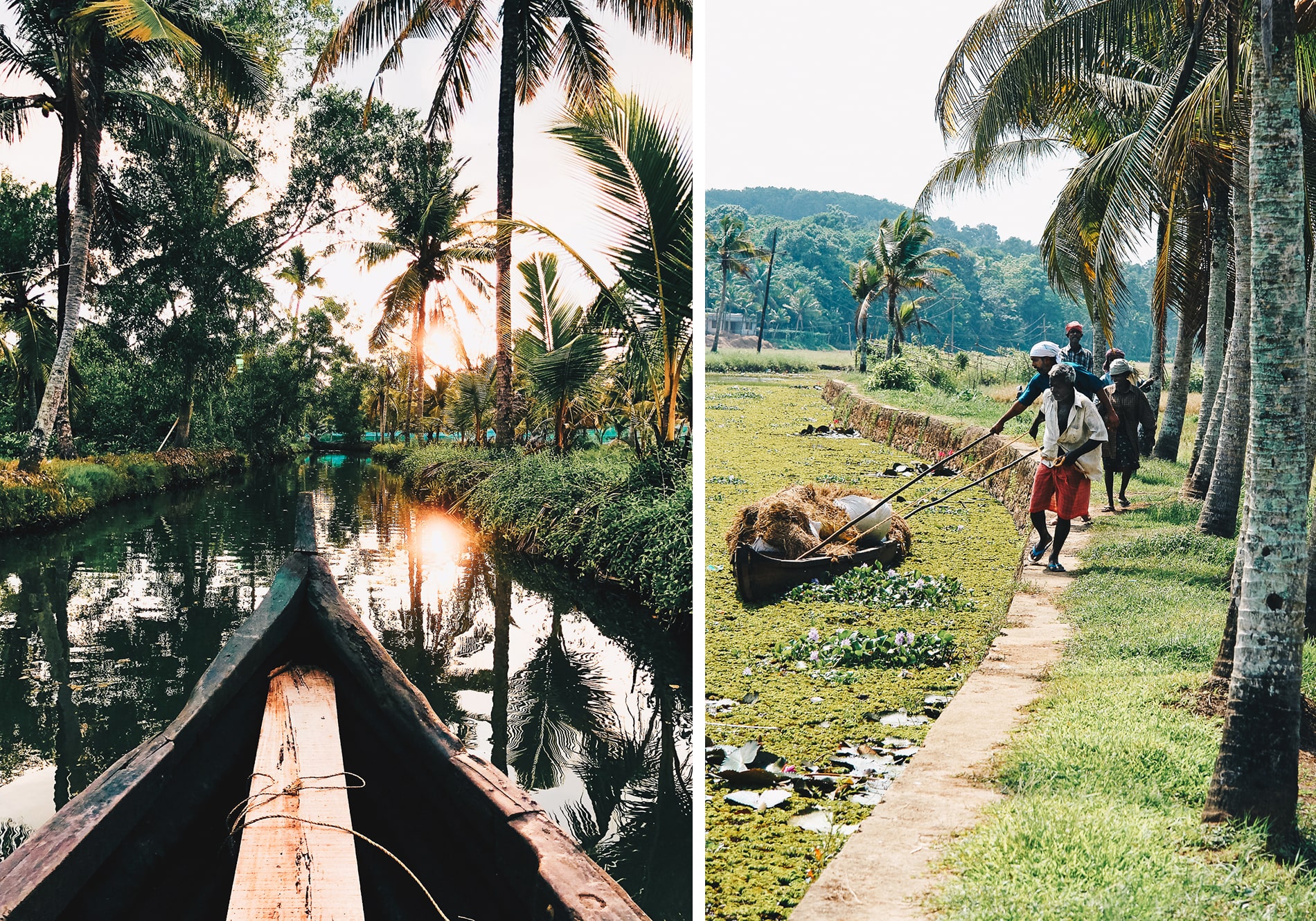
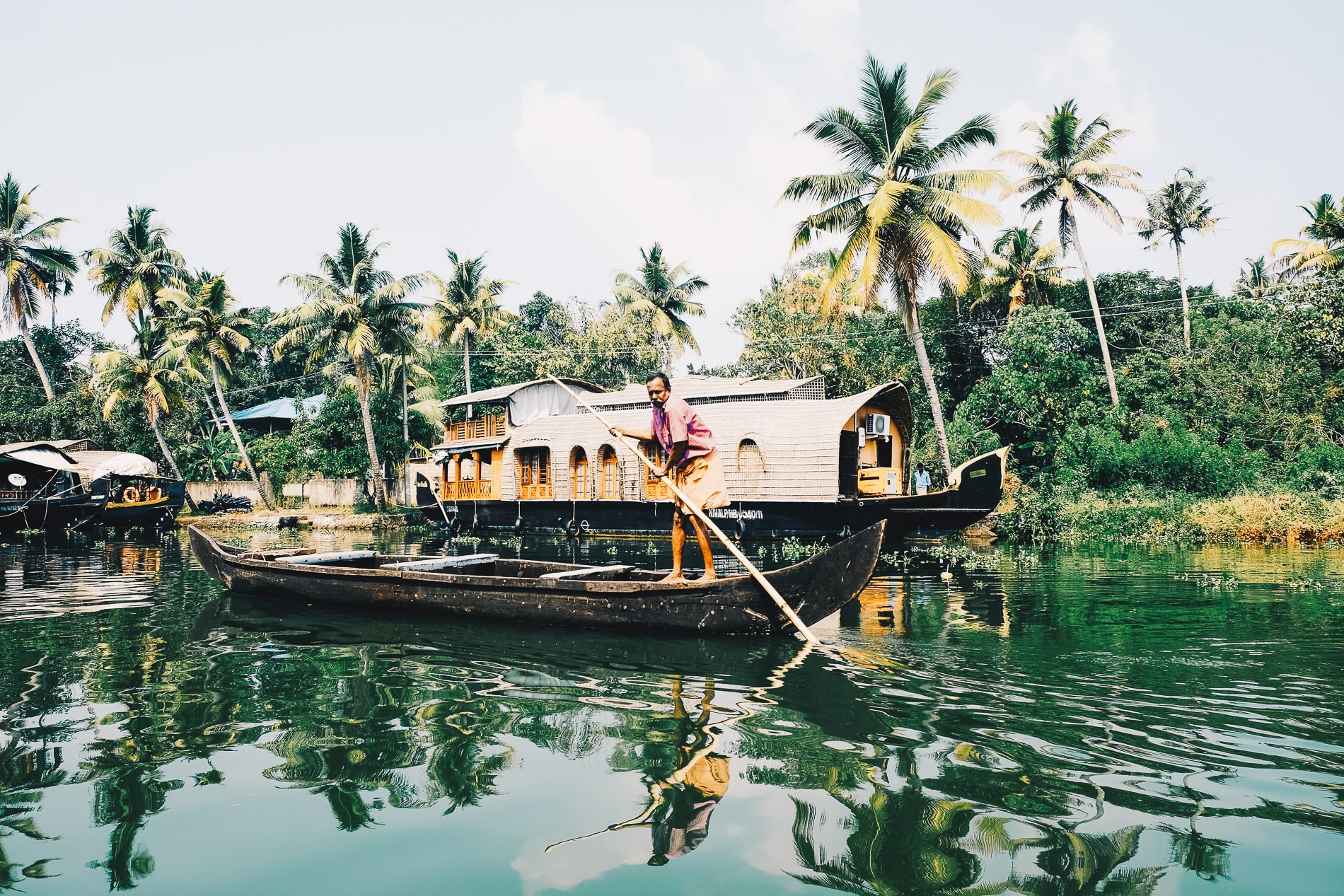
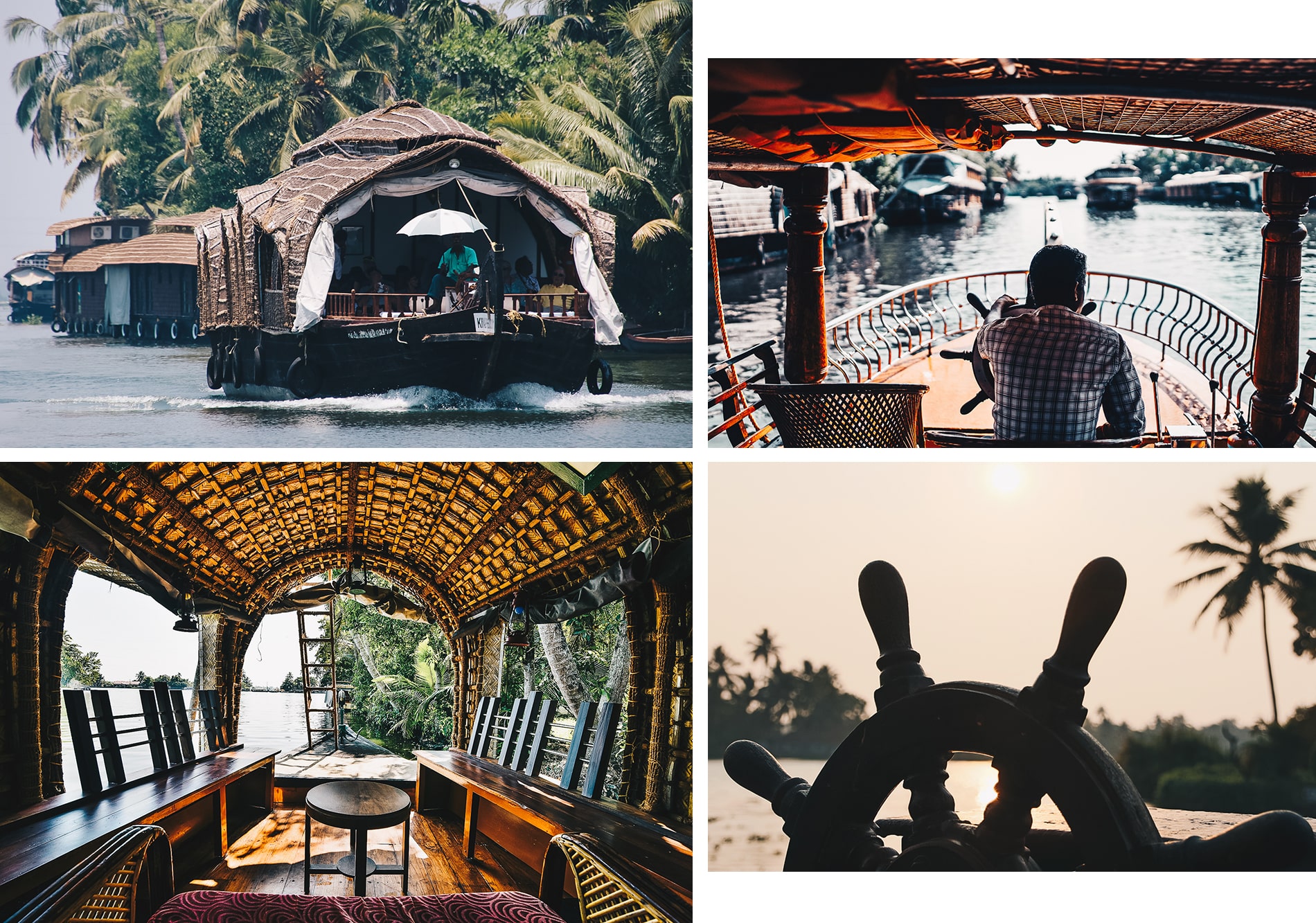
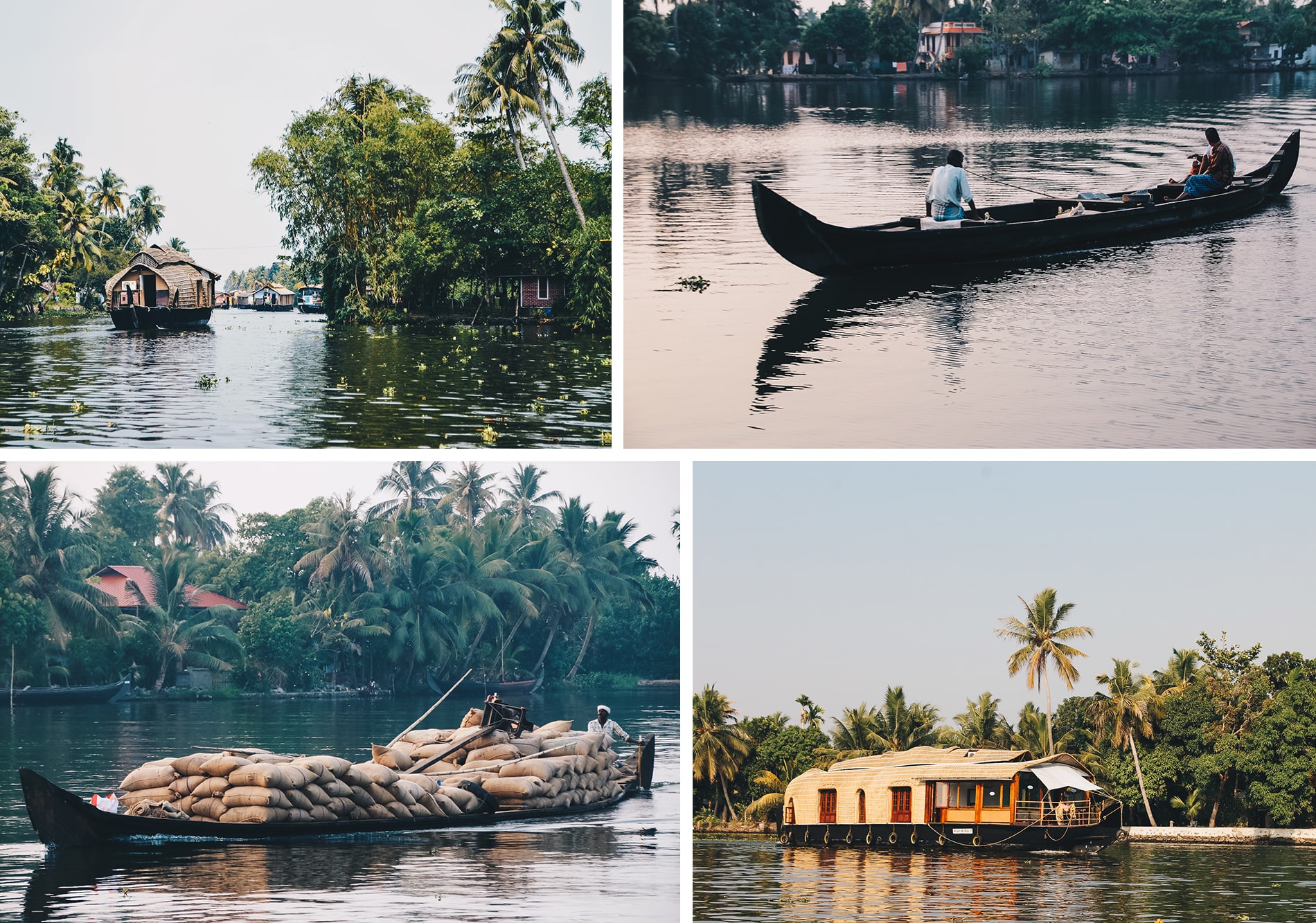
Finally, on the way to Allepey, if the temperatures are around 35 degrees as we had in March, take the time to stop off at the beach at Marari (15km from Allepey), with its long white sandy beach, leaning coconut palms, fishermen and their small boats, for sunbathing and swimming! And yes, Kerala also has long, beautiful beaches. By way of illustration, the beach at Kovalam is said to be one of India’s most famous but very touristy towns. I’ve also heard of Gokarna beach located in the far north of Karnataka, from Kudlee beach within walking distance of Gokarna, OM beach, Half moon beach and paradise beach. There’s plenty of choice when it comes to sunbathing.
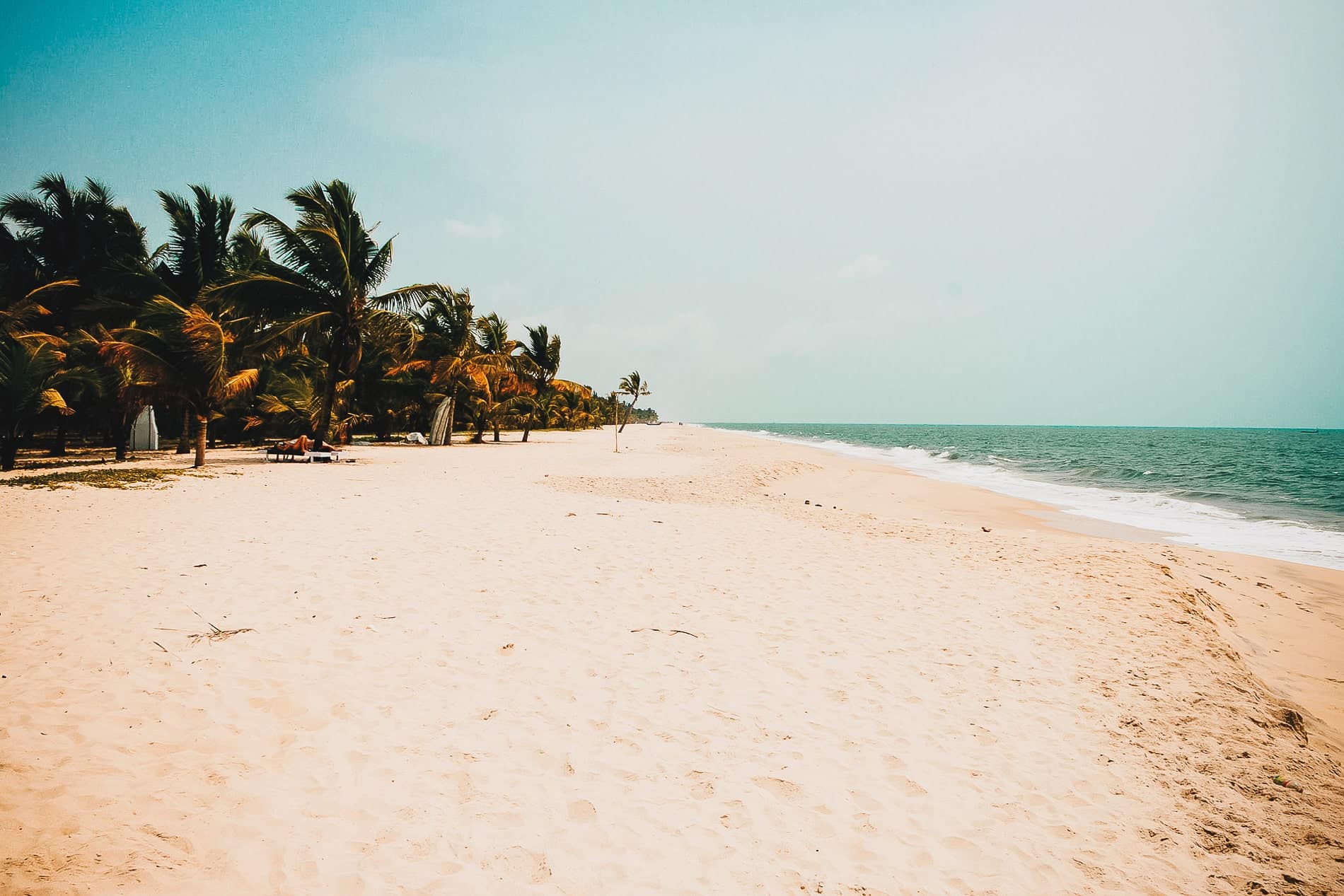
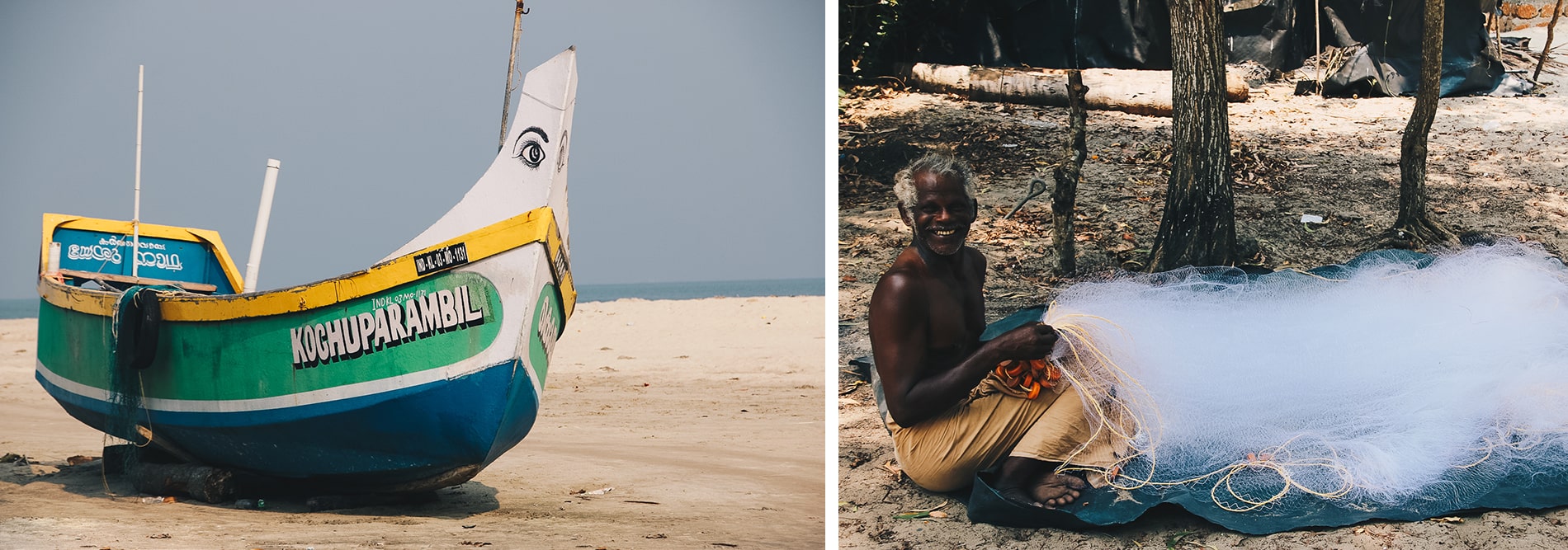
| PERIYAR
Our next stop takes us to Periyar, a stopover worth visiting for its mountainous, bucolic setting: perched 1,200 m above the furnace of the plains, it makes a good, relaxing holiday resort. The more hilly area abounds in spice plantations. Periyar means “great lake”, and it’s in the Kumily region that the country’s finest cardamom is produced. And yes, India is, of course, the world’s leading exporter of spices. We recommend spending at least one night in a pretty little guesthouse on a plantation to enjoy the scenery. You feel like you’re in the countryside, with everything at your fingertips in the garden. You can also discover the different spices produced here, such as cardamom, nutmeg, cinnamon, pepper… In fact, we wrote an article about it for you.
I have a great inn to recommend, Visit Manayath Heritage which is one of my favorite places to visit the spice plantations. The panoramic view is splendid and highly instructive!
In the evening, around 6pm, you can also enjoy a Kalaripayattu show at the Kalari Centre or Yodha Cultural Village. Nothing to do with the kathakali we saw in Cochin. This time, it’s an Indian martial art (the oldest of the martial arts) mixed with acrobatics, which is said to be the origin of martial arts in China. Spectacular and entertaining, it’s quite impressive to watch from the small arena where we’re seated, as these performances unfold before your eyes.
Don’t leave Periyar without visiting its 777-hectare protected reserve. km ², known to be home to a vast reserve of animals, including some forty tigers (difficult to spot, apparently, as the territory is vast and the chances of seeing any are very slim). The Periyar National Park also known as Thekkady lies on the slopes of the Western Ghats and has a large lake in the center, a strategic watering place as it’s where all the animals come to drink. This park is a protected area teeming with abundant flora and fauna: macaques, hinds, buffaloes, antelopes, wild goats (tahr nilgiri), elephants and many other animals that can be spotted on a safari or boat ride. This was one of our regrets of the trip, as we hadn’t included it in the program.
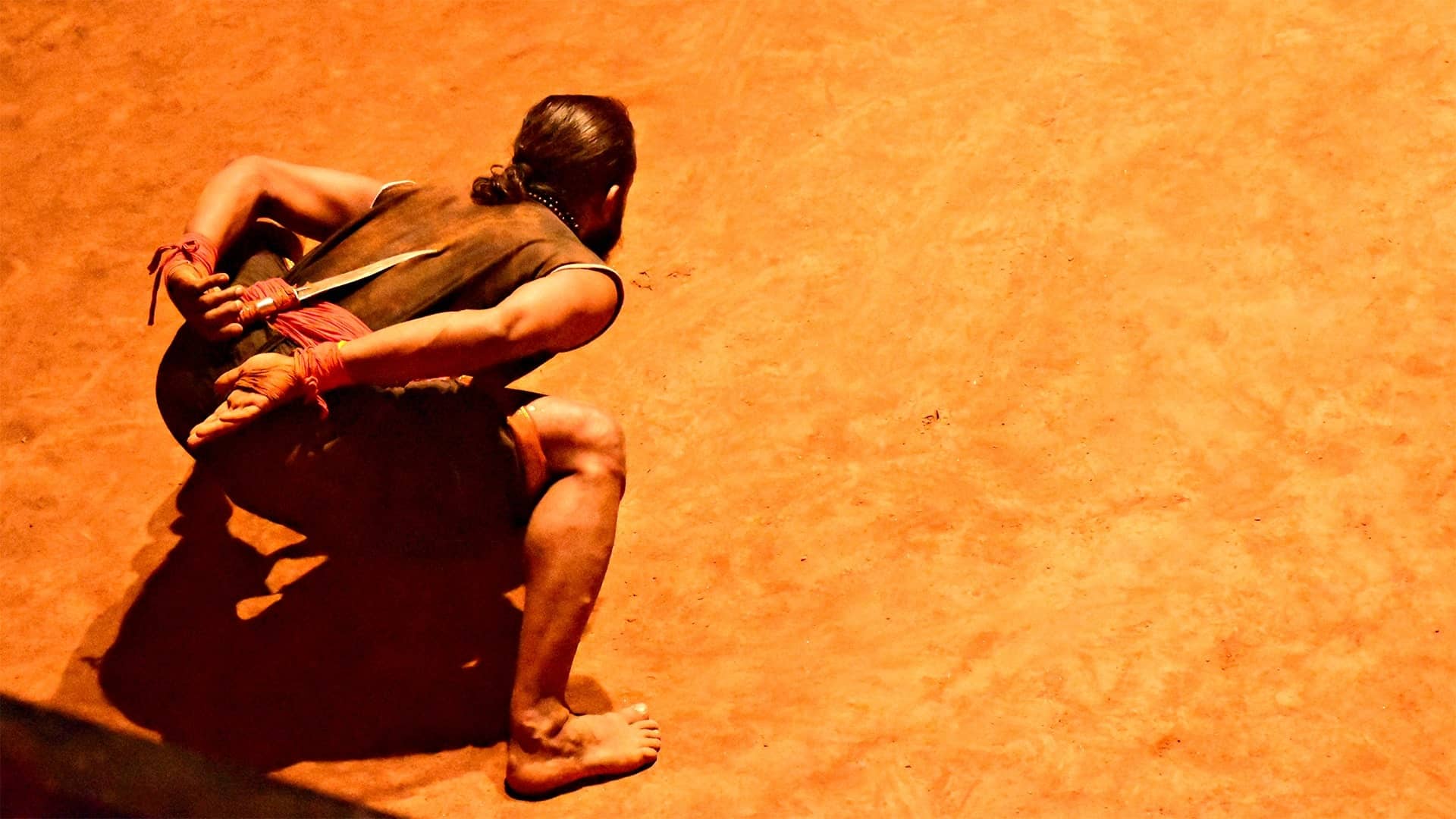
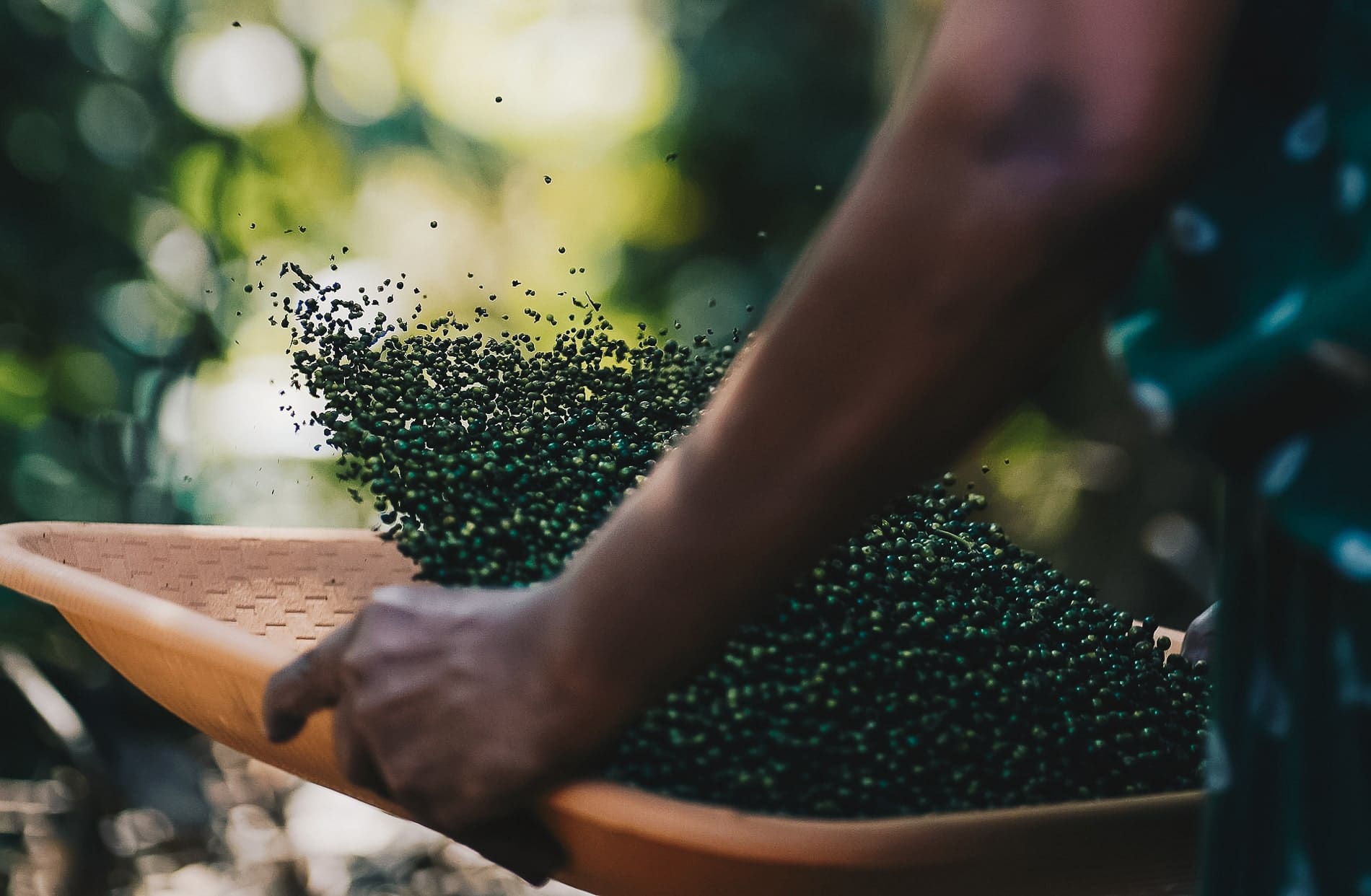
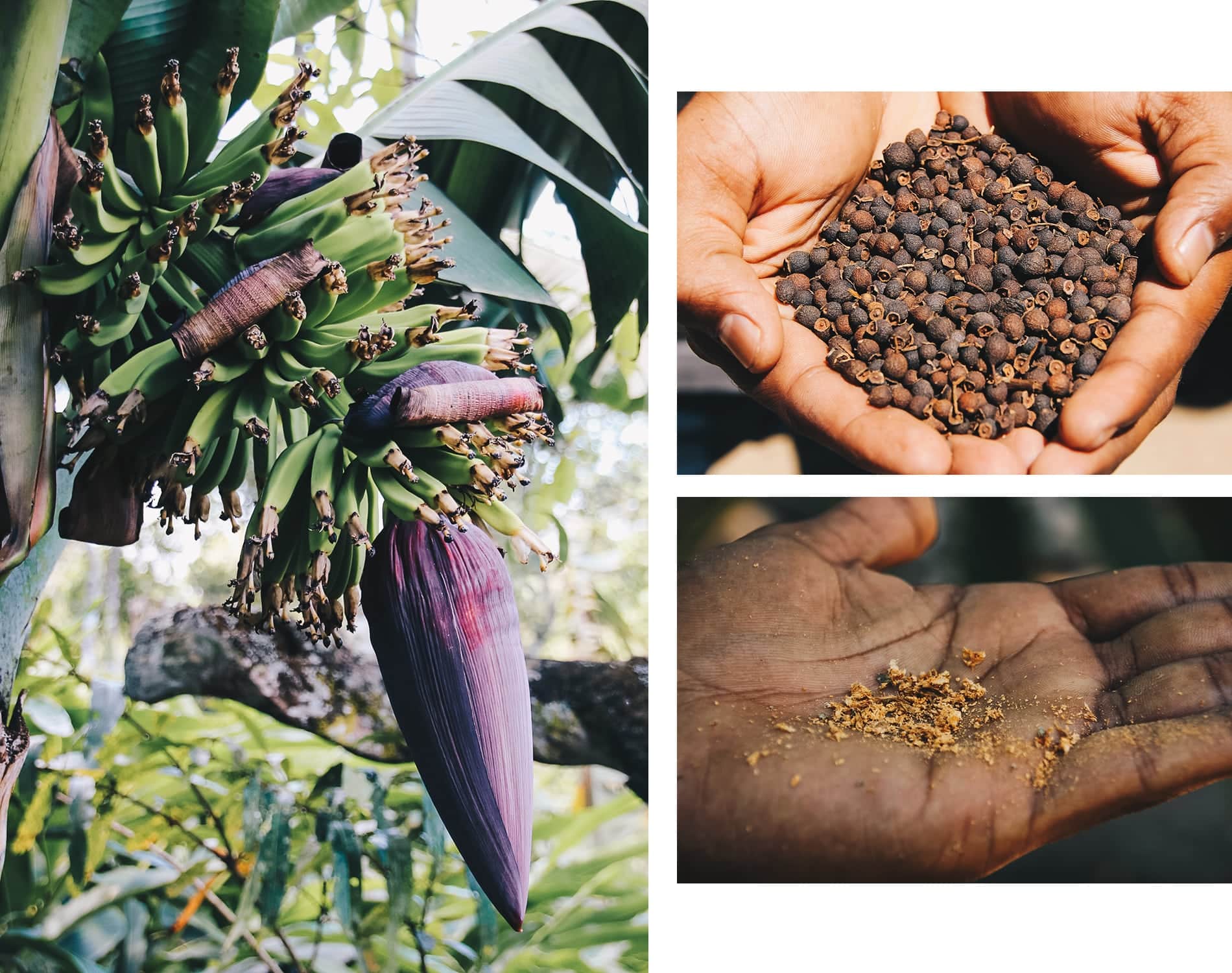
| Où dormir à Periyar ?
Si comme nous, vous aimes les hôtels de charme, voici notre sélection coup de cœur:
- Spice Village
- Noah’s Nest Tree House
- Amritara Shalimar Spice Garden
- Niraamaya Retreats Cardamom
- Bluebell Resort
- Wonder hill Wayanad
➡️ Regardez aussi les petits homestays sur Airbnb et 💰 Profitez jusqu’à – 40€ sur votre réservation Airbnb en cliquant ici
➡️ Si vous n’avez pas trouvé votre bonheur en terme, nous vous invitons à consultez les meilleures offres et réservez sur booking.
| Où manger ?
- Grandma’s Café (Thekkady Byepass Road near Green View Residency)
- Coffee garden (Thekkady Bypass Road)
- Ebony’s Café (Bypass Road)
| Activités à Periyar
- Spectacle de Kalaripayattu
- Ferme à épices
- Parc national de Periyar
- Cours de cuisine avec les locaux. Nous avons passé un très bon moment avec ce charmant couple qui nous a reçu dans leur maison. La cuisine est facile à faire et surtout très bonne.
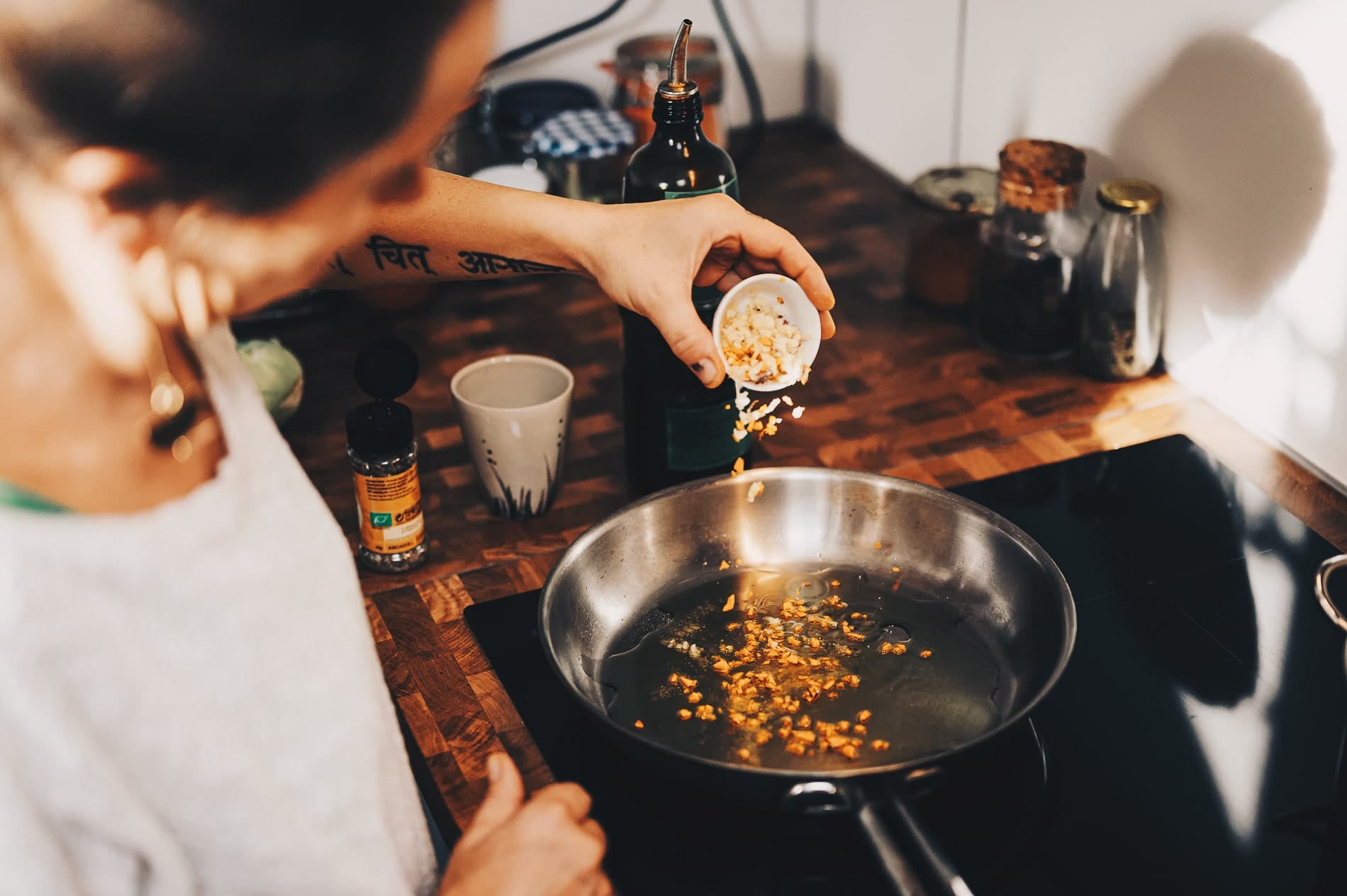

| MADURAI
We take a day out from Kerala to visit Madurai, the cultural capital of Tamil Nadu. The road into Tamil Nadu is a beautiful one, lined with rice paddies and alive with scenes of life. An opportunity for us to stop by the roadside and chat with the locals. The town of Madurai is known for its original temple, “Sri Meenakshi “ located in the heart of the city, very colorful and celebrating notably the God Shiva. This one is almost entirely blue and adorned with numerous statues. Its 11 towers, 4 of which are 60 metres high, are a must-see. Please note that camcorders and cameras are not allowed inside, and that proper attire is required: no shorts, no short skirts, no bare shoulders.
Madurai is also famous for its jasmine flowers, which Tamil women weave into their hair. The town also boasts a flower, banana and vegetable market, which makes for a pleasant morning stroll! It’s an explosion of colors and scents at this market, and an ideal place to chat with the locals. Their smiles and kindness will touch you. Finally, if you love museums, don’t miss the Gandhi Memorial Museum, which retraces Gandhi’s life.
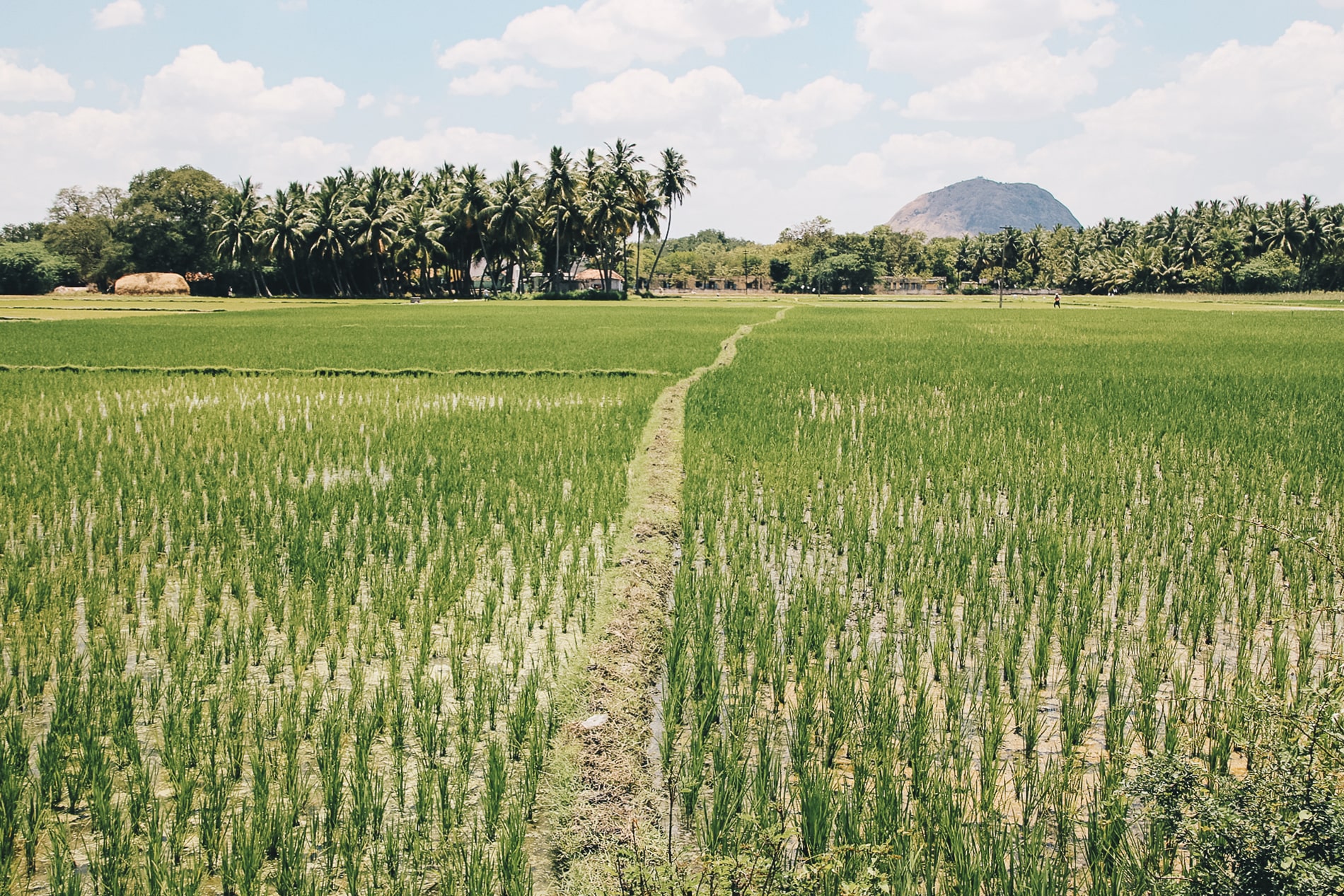
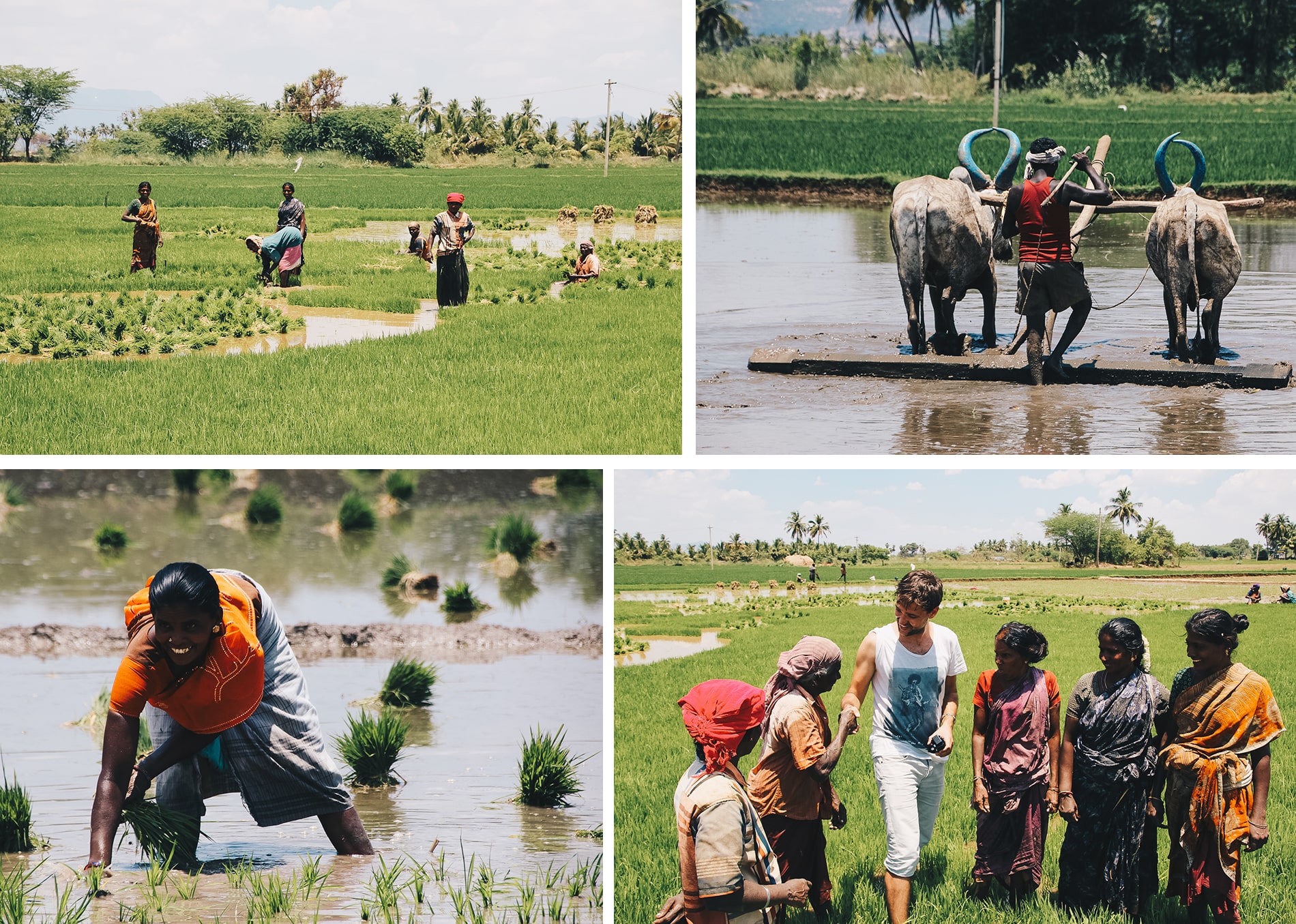
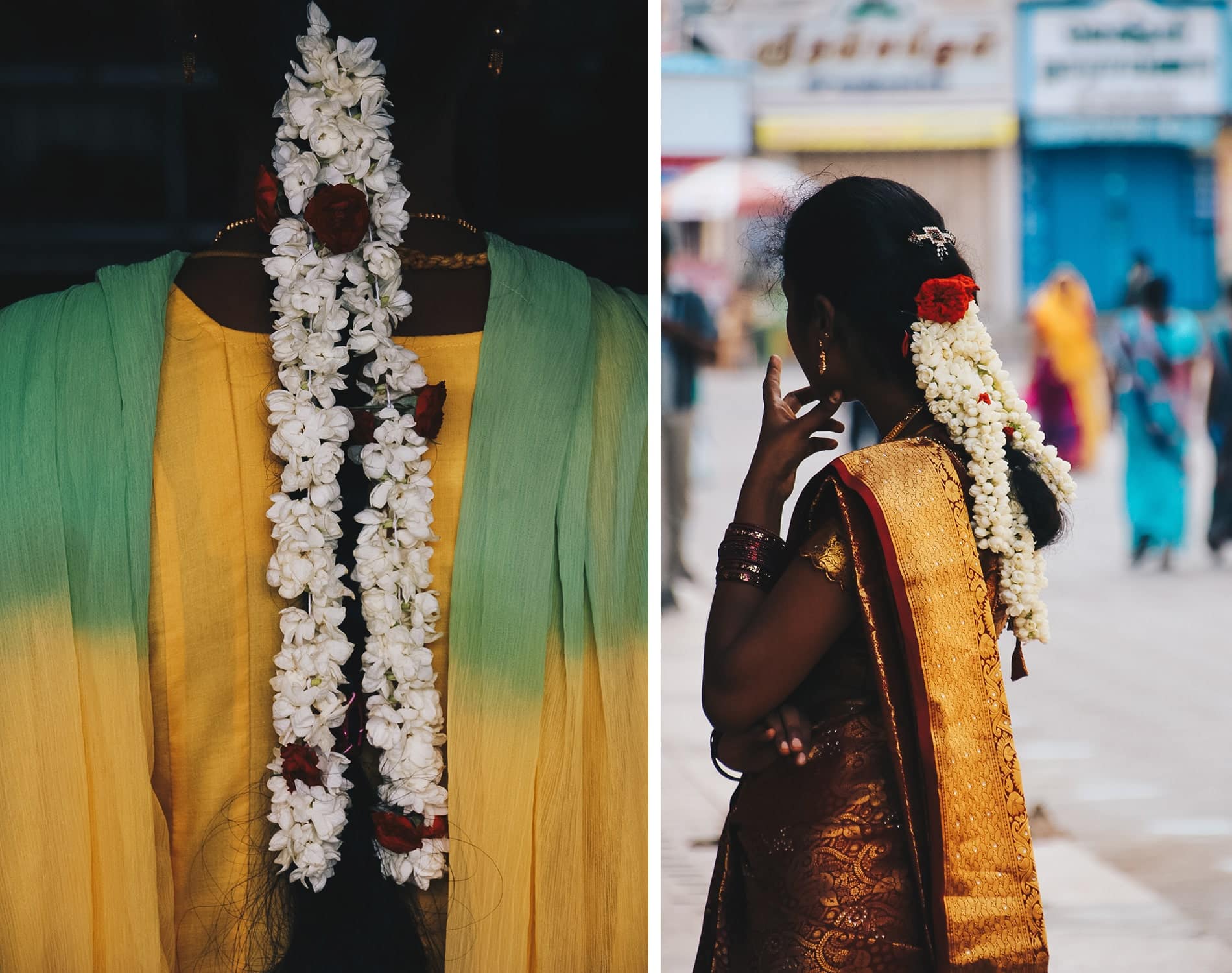
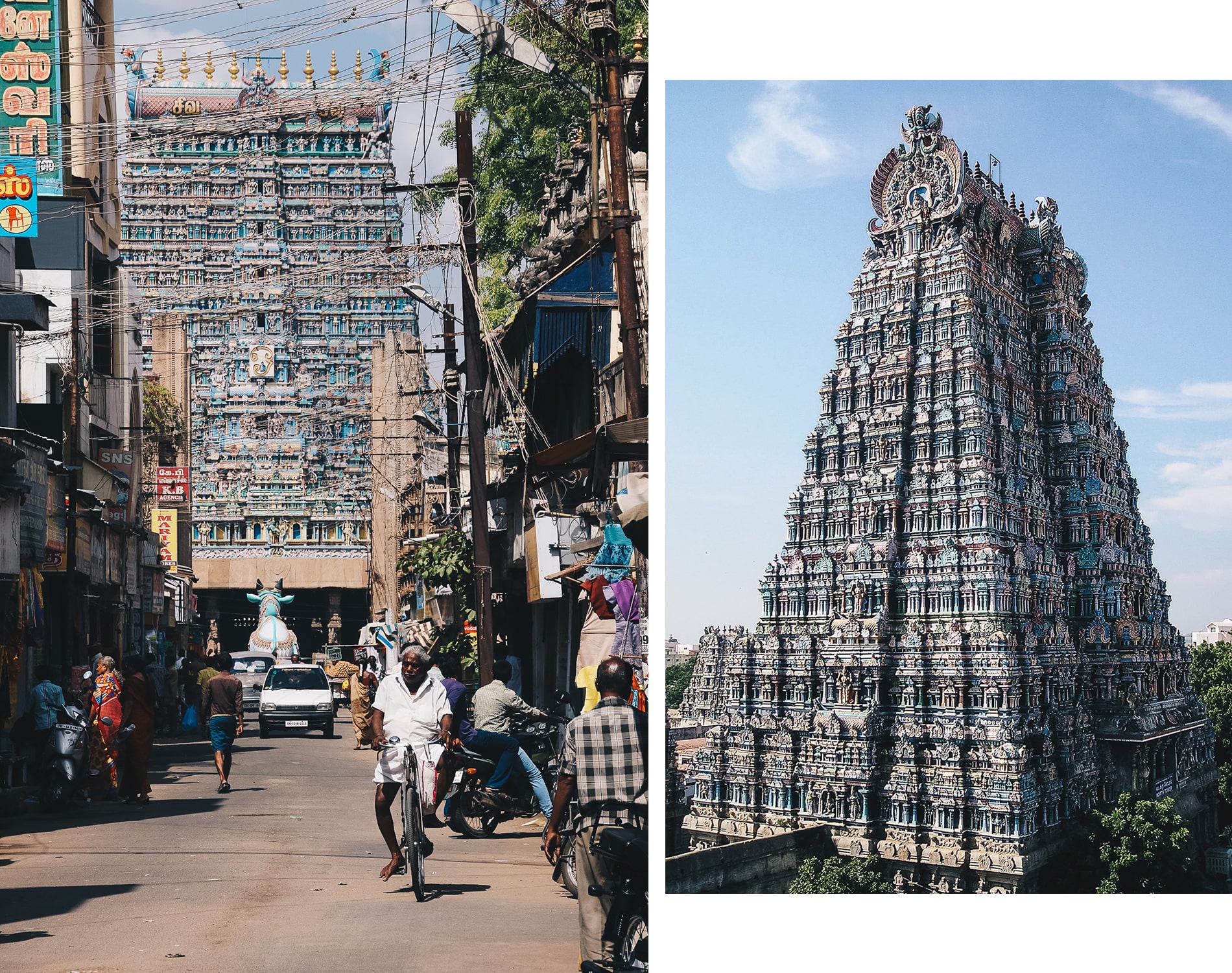
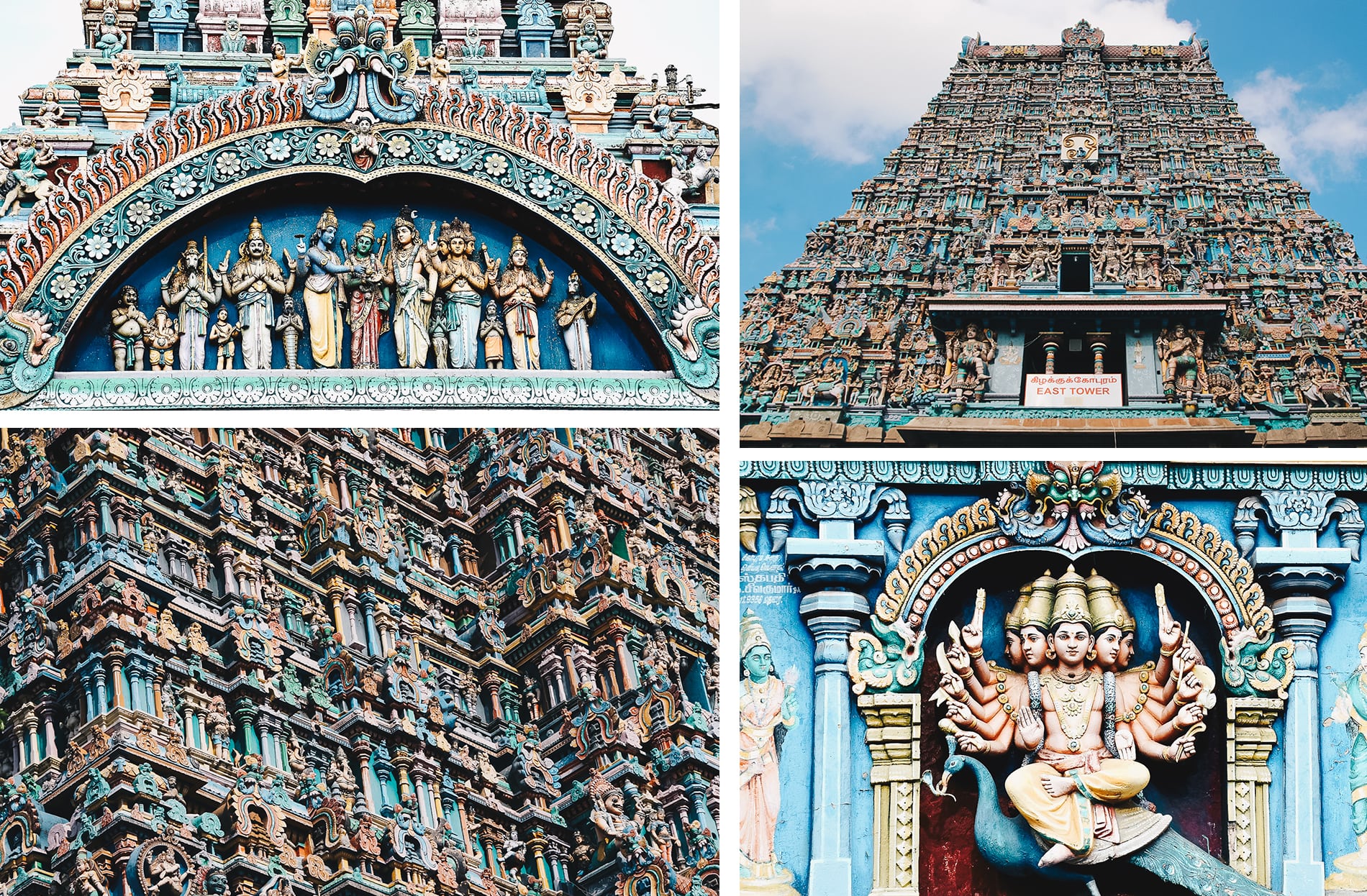
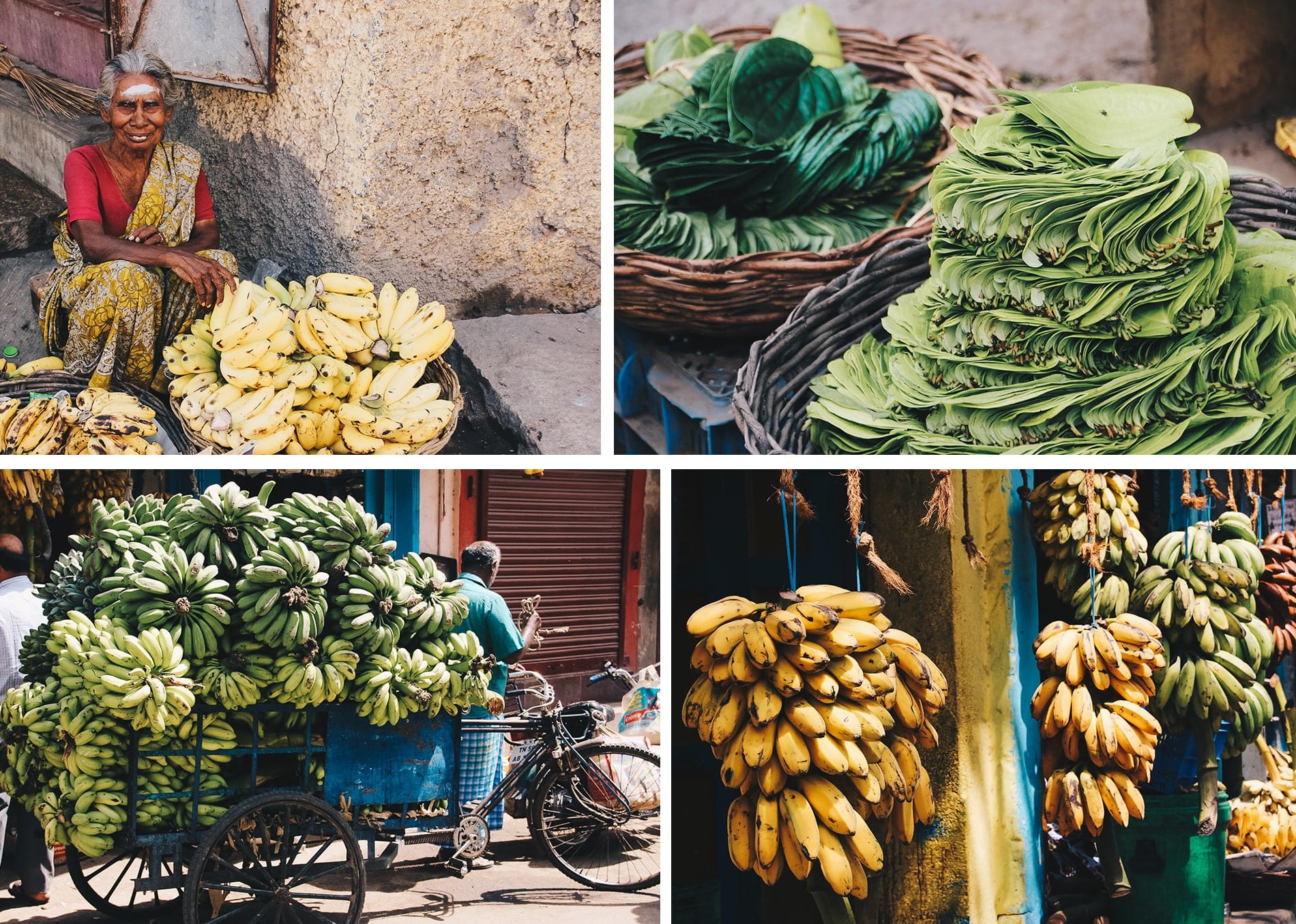
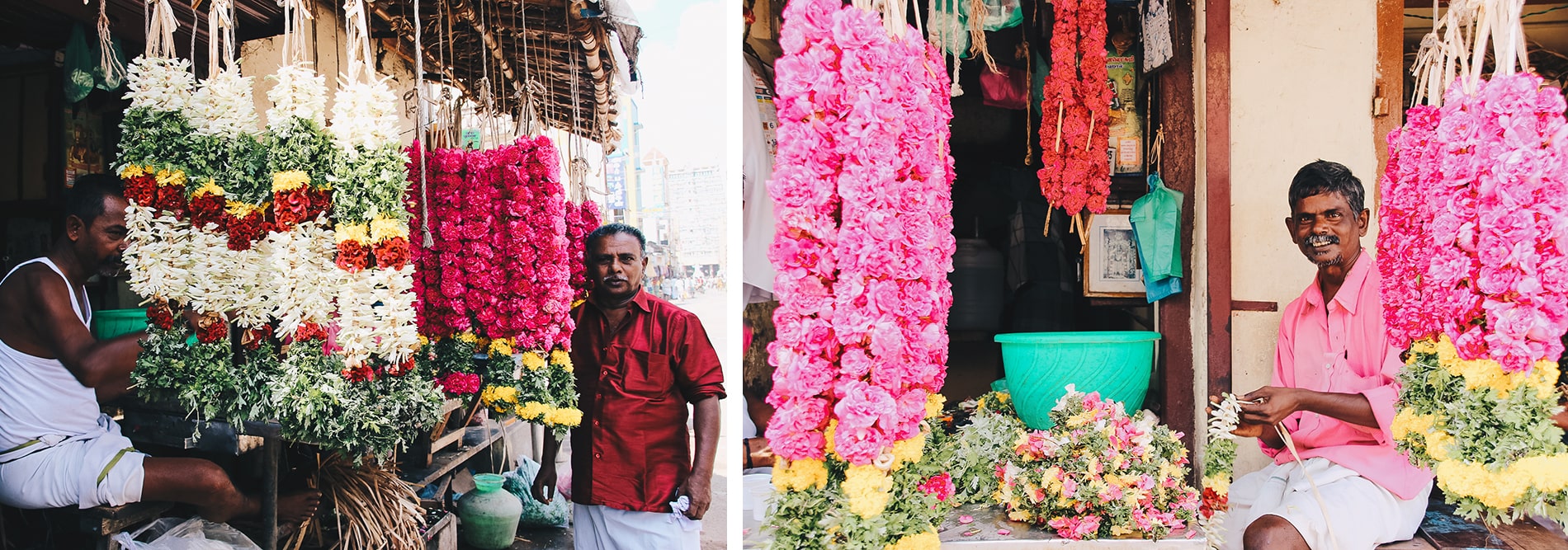
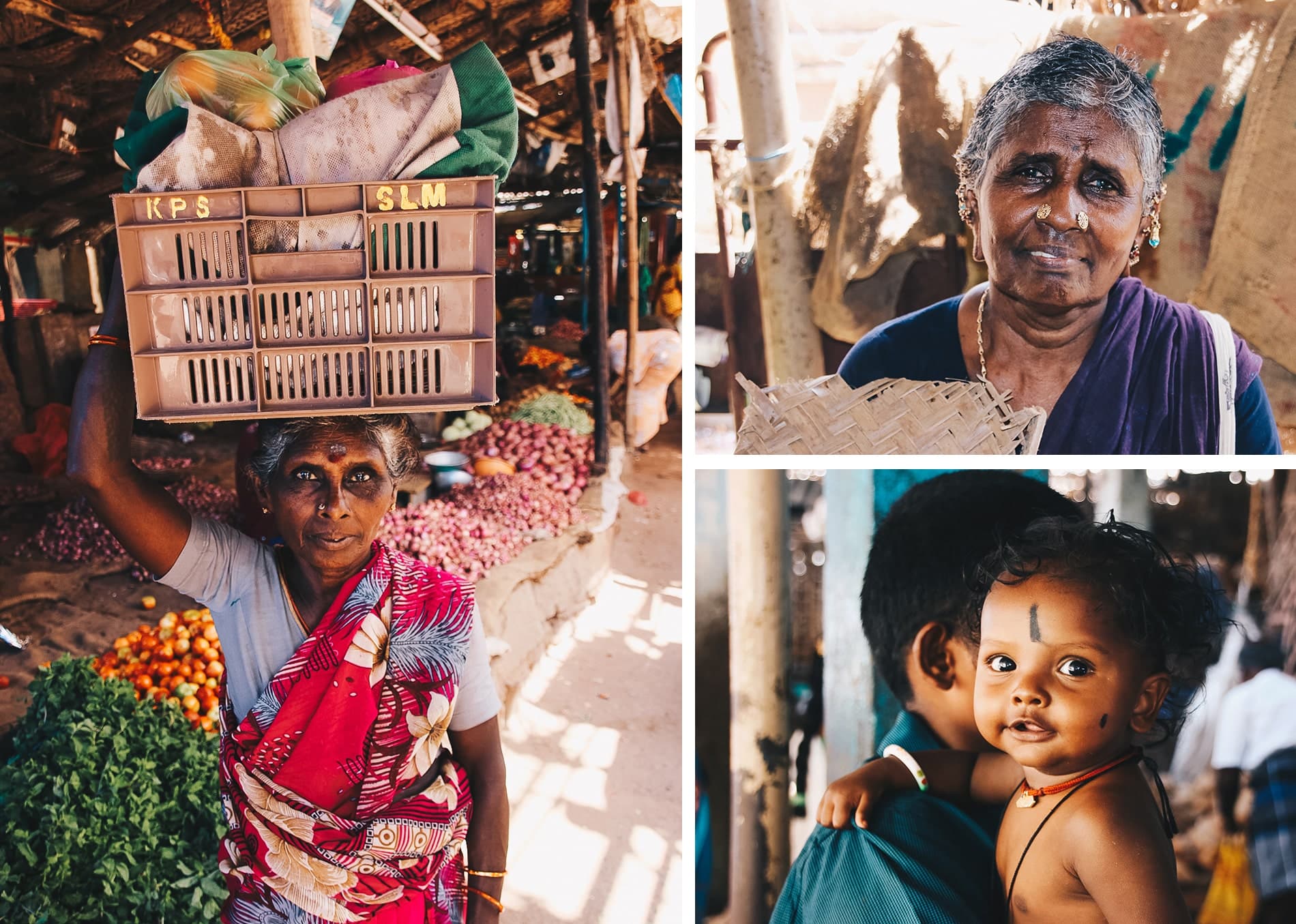
| MUNNAR TEA PLANTATIONS
Make way for the more mountainous areas of Kerala. Here we are in Munnar with its tea plantations, I would even say the “valley of teas” perched at an altitude of 1600m and shaped by the hands of man over 10,735 hectares. The road to this town is winding, on a mountainside and far from easy, but it’s a real beauty. Picture-postcard landscapes await you. People come to Munnar to breathe the pure air of nature, to meditate and to find peace and quiet. It’s an essential stop on the route, even if it is touristy.
A quick look back. These plantations were planted by the British around 1875 1, importing plans from China, then handed over to the Indian government and handed over to the powerful TATA group at the time of independence, as the Indian workforce came from cities where unemployment was high. These plantations literally shape the landscape. It’s like being in a gigantic English garden. It’s simply magnificent! But it’s the hands of the pickers who work 7 hours a day in the steep terrain that make this landscape so distinctive. It’s not necessarily easy to go and see them while they’re cutting tea, as their yields are controlled.
It’s best to work with an agency that has links with an Estate, so you can go for a walk, have a chat and even be tempted to pick your own. What’s more, you’ll have the chance to go inside the tea factory and find out how the tea is made.
Before coming here, we knew that tea was made from leaves, but that’s all.
- The plans
The first thing that stands out is the way they are cut, at around 1.5 metres high. We agree that the tea plant is a tree, and like all trees, it grows. Here, they are this size so that the 350 pickers employed by the company have no difficulty in pruning them. The leaves used for tea are the young shoots at the top of the tree, cut every 10 days or so. The lifespan of a tree is around 100 years, and when we replant a shrub, we don’t collect its leaves for the first 5 years.
The higher the altitude of the trees, the higher the quality of the final product.
Finally, they are planted on sloping ground, as tea needs water but not too much. And yes, the slope means no stagnant water or waterlogged soil. You just had to know. You’ll also find large trees in the middle of the plantations to provide shade for the tea.
- The different teas
You’re probably familiar with black, green and white teas, but what are the differences? We’ll try to sum it all up in a few lines!
The black tea is the first grade of tea, made with the larger leaves from the top of the tree, offering less important taste qualities. There are 2 manufacturing techniques: one in which the leaves are crushed and the other in which they are rolled, then in both cases oxidized before being dried.
As photography is forbidden inside the Factory, we can only advise you to go and see for yourself, and smell the tea in the halls. The tour ends, of course, with a tasting of the different types of tea.
The green tea is made with younger, fresher leaves. The process is slightly different, since the leaves are first steamed, then systematically rolled, and do not undergo the oxidation stage.
The white tea is made, for its part, from just-opened young shoots and is dried by hand and oxidized naturally and manually in the sun. It is the finest of teas, and the most expensive too.
In a nutshell, white, green and black teas come from the same plant, but the leaves are picked at different stages of ripeness and processed differently. White tea is the most expensive because it’s the most precious, and its leaves are harder to cut because they’re smaller. Black tea leaves are withered, rolled, fermented and dried, whereas green tea is unfermented.
- Tips for drinking your tea
What we can advise you to do now is buy your own white, green or black tea, take it plain and add your own spices. Just drop a slice of lemon, crushed ginger, cinnamon, rose, open cardamom or whatever you like with your tea into the infusion. You’ll get your very own, made-to-measure tea, and as you know, there’s none better.
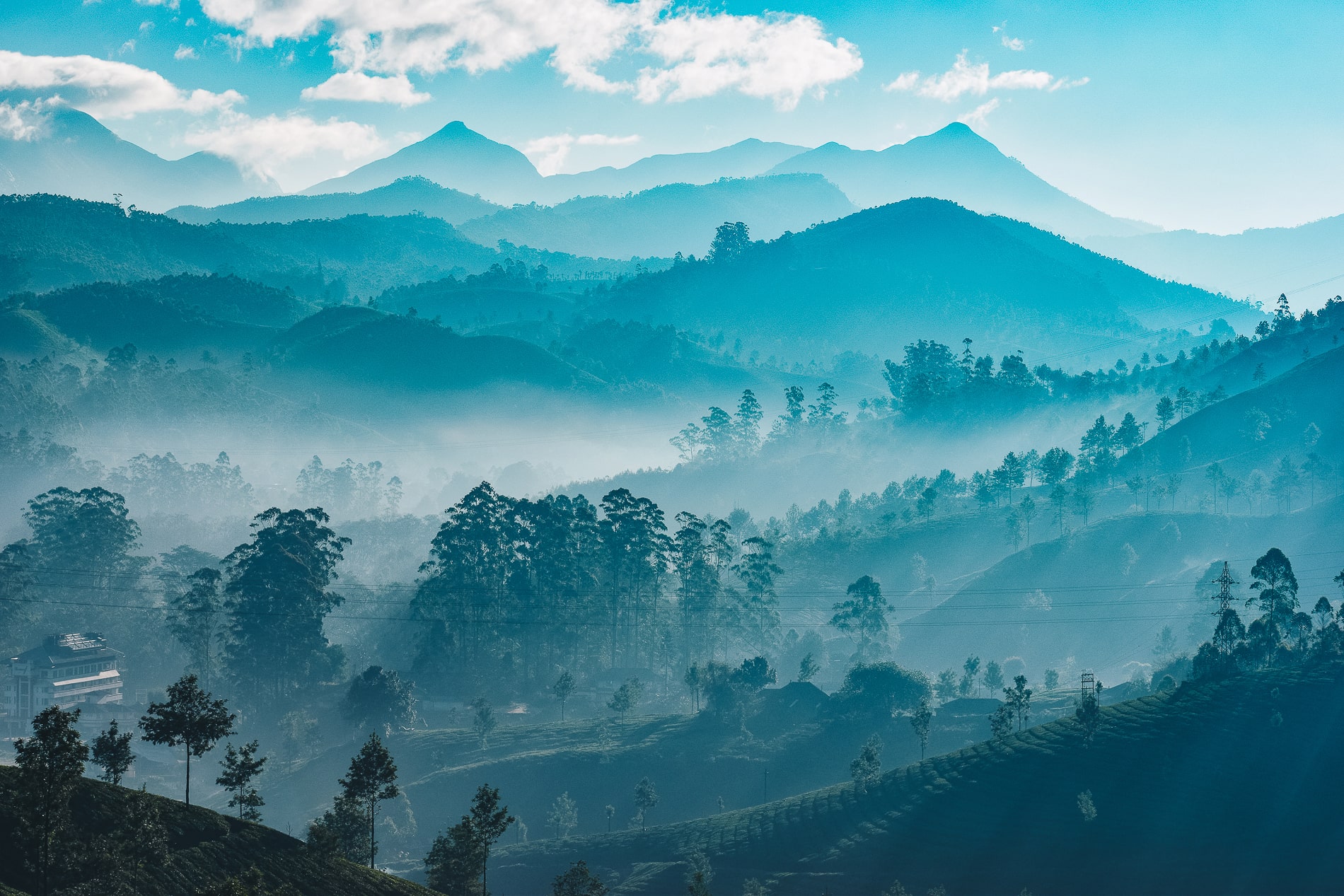
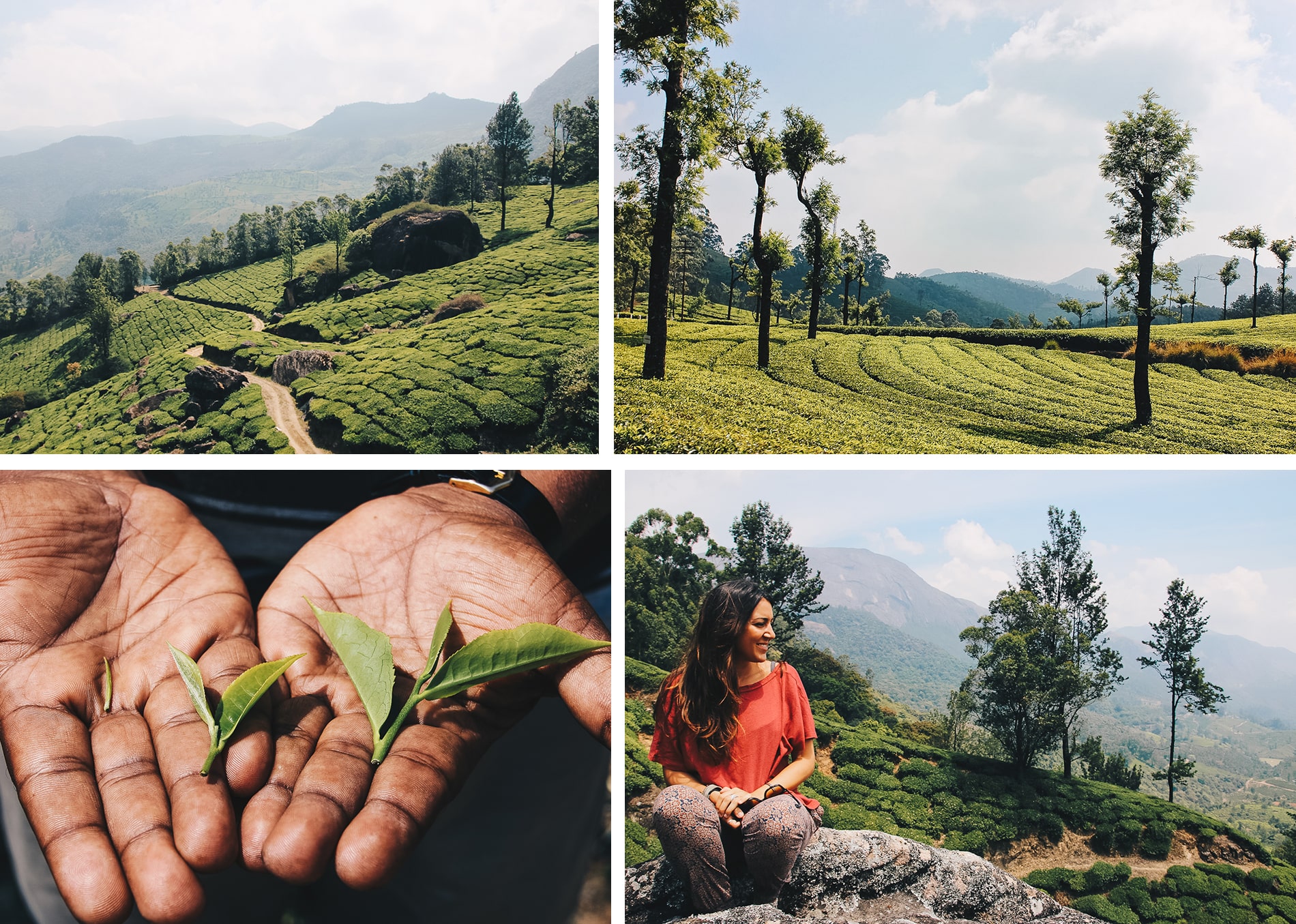
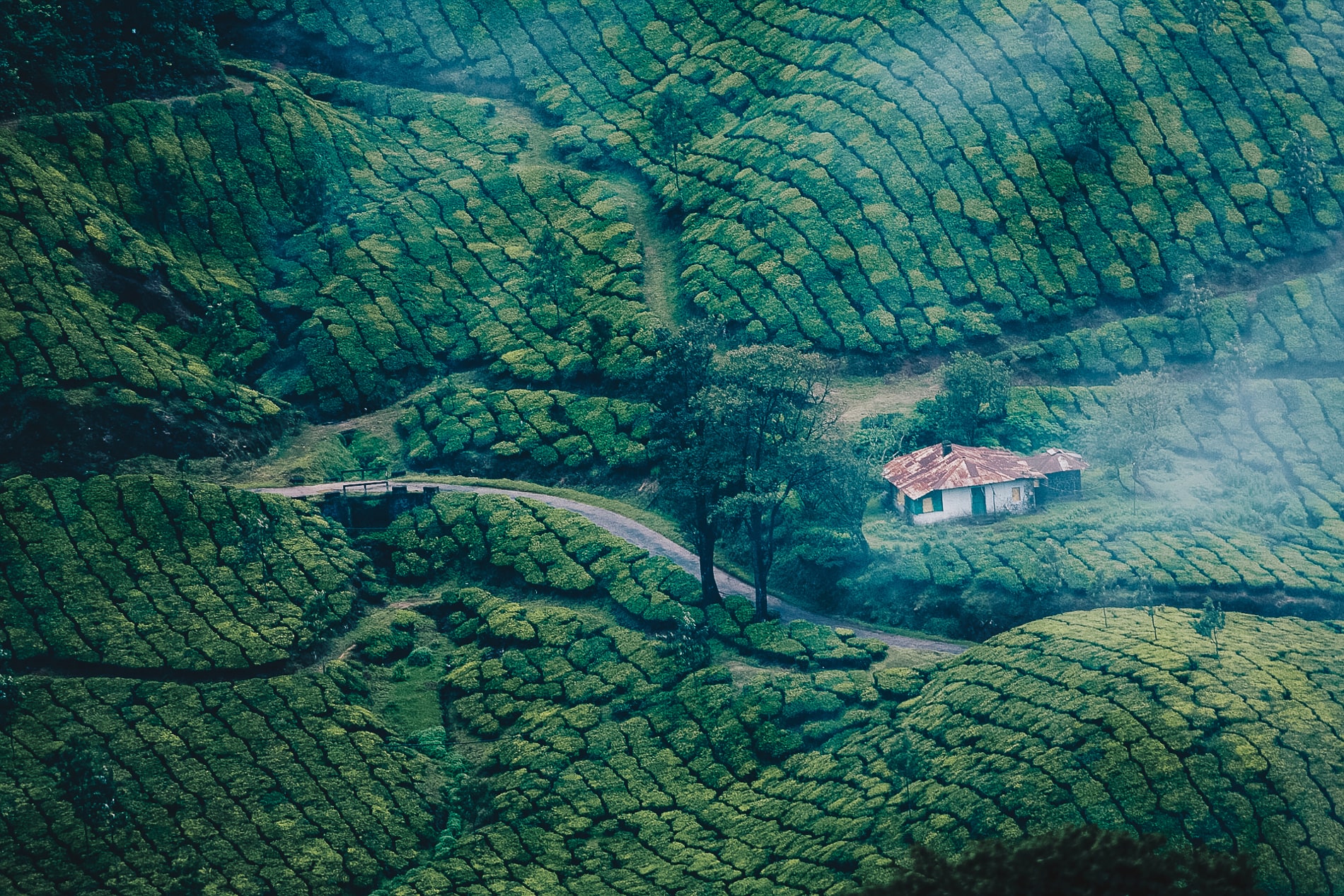
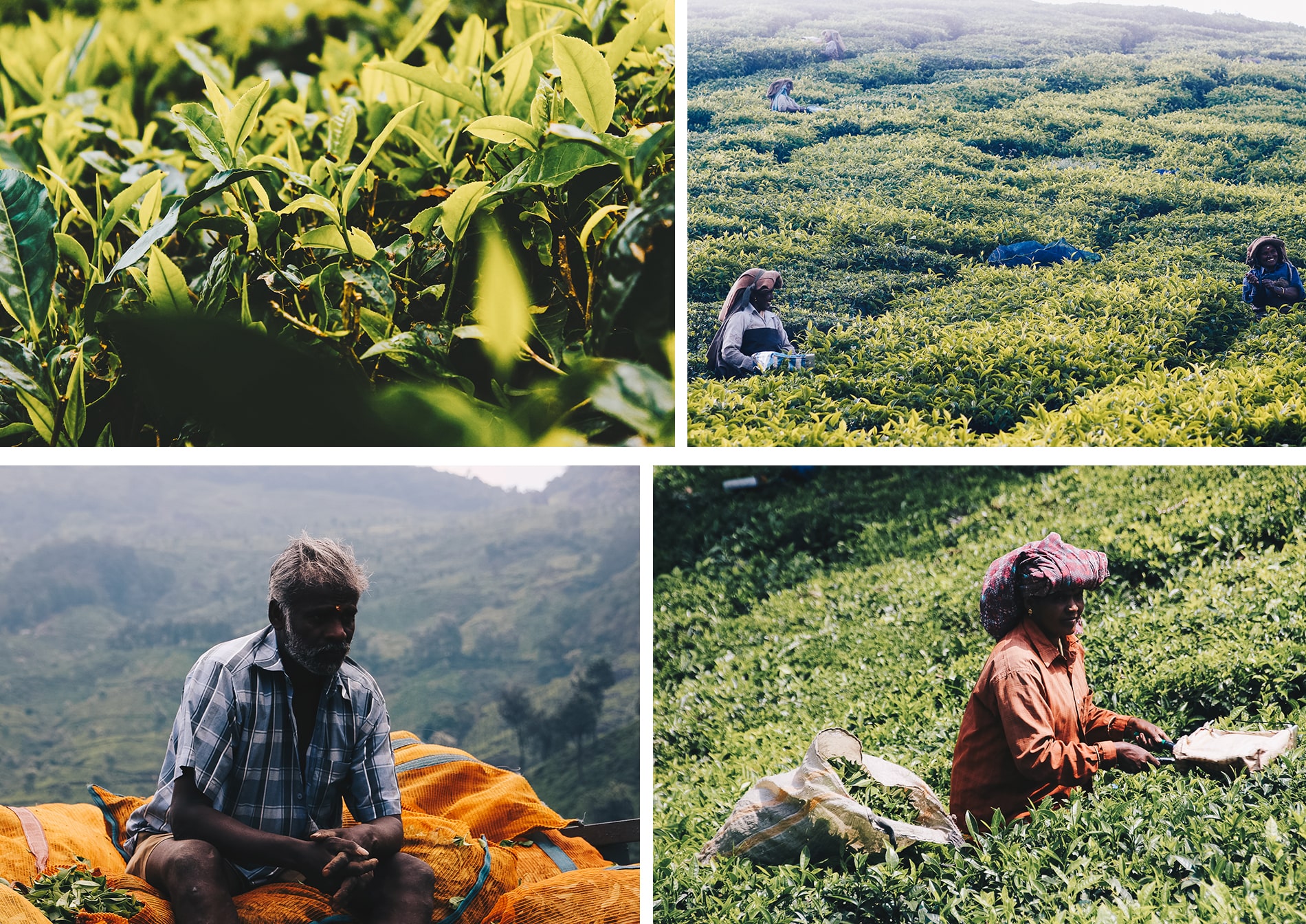
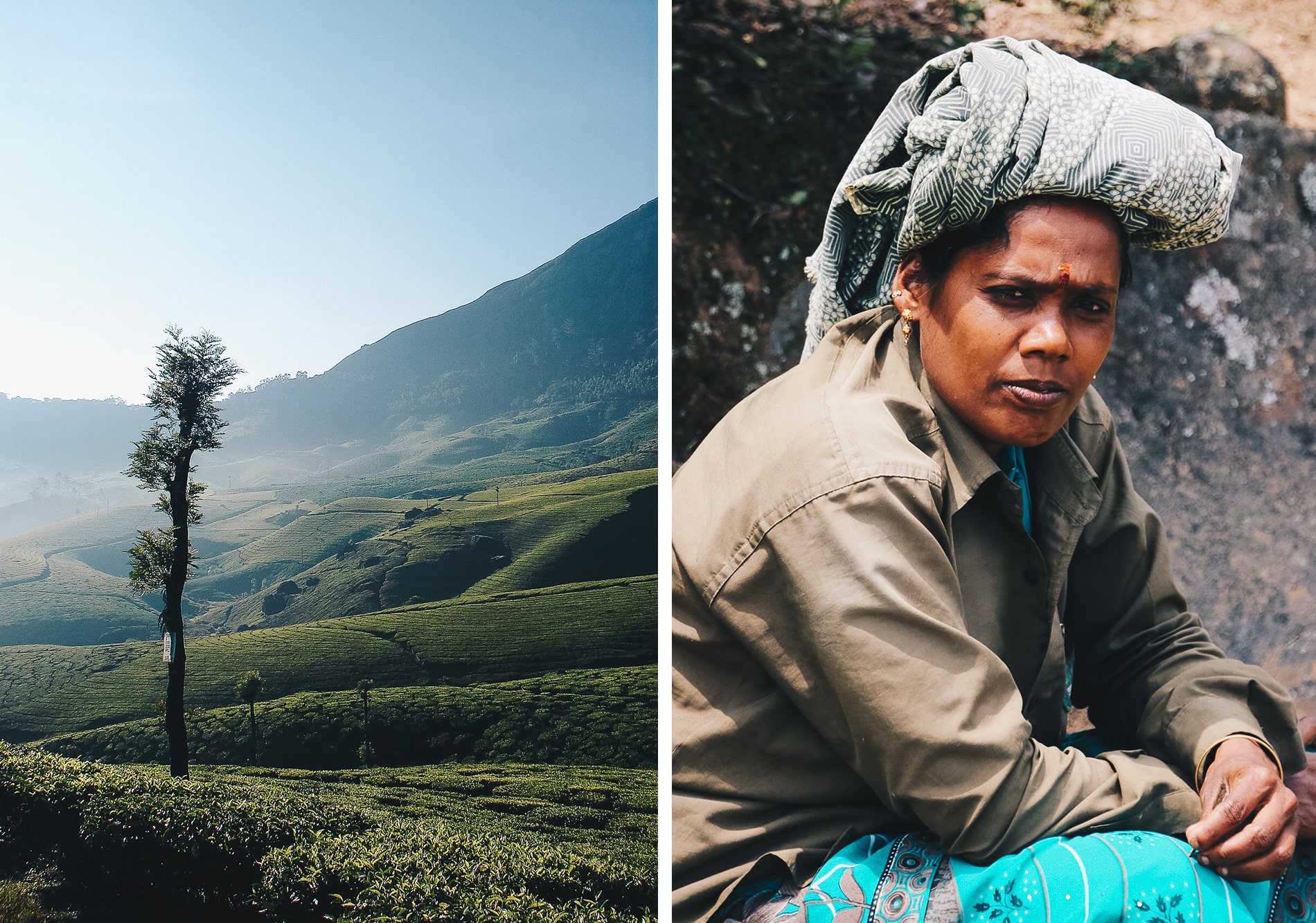
| Où dormir à Munnar ?
Si comme nous, vous aimes les hôtels de charme, voici notre sélection coup de cœur:
➡️ Sur Airbnb, vous pouvez aussi réserver cette maison atypique, The MudHouse Marayoor ou cette très jolie Homestay Mistletoe Homestay and Cafe Room 1. 💰 Profitez jusqu’à – 40€ sur votre réservation Airbnb en cliquant ici
➡️ Si vous n’avez pas trouvé votre bonheur en terme, nous vous invitons à consultez les meilleures offres et réservez sur booking.
| Où manger ?
- Bamboo cafe (Lake Road Thekkady Homestay, Thekkady)
- Rapsy Restaurant (Proche du bazar Centre de Munnar)
- Rivulet Restaurant (Power House, Chithirapuram, Aluva – Munnar Rd, Munnar)
| Activités à Munnar
- Trek à travers les plantations de thé avec un guide et visite d’une usine de fabrication de thé.
- Tester le massage ayurvédique, nous vous racontons ici notre expérience.
- Trek dans les Letchmi Hills pour profiter des vues pittoresques des Ghâts occidentaux et baladez-vous hors des sentiers battus dans les collines de Lakshmi.
➡️ Vérifiez les disponibilités du trek et réservez ici
| ATHIRAPPILLY WATERFALLS
It’s a step we missed on this trip, and one we also regret. The Athirappilly waterfalls, nicknamed the Little Niagara Falls, are the largest waterfalls in the south of the country and aa major tourist attraction in Kerala. The walk up to the waterfall is apparently tiring, especially in the heat and humidity, and because the steps are quite steep and high. It’s inaccessible to wheelchairs and the elderly. At the bottom, the view is magnificent with an impressive water flow. You’ll enjoy the refreshing spray. Swimming is prohibited.
We have a hotel to recommend with a view of the falls, the Rainforest Resort, for a luxurious, relaxing stopover.
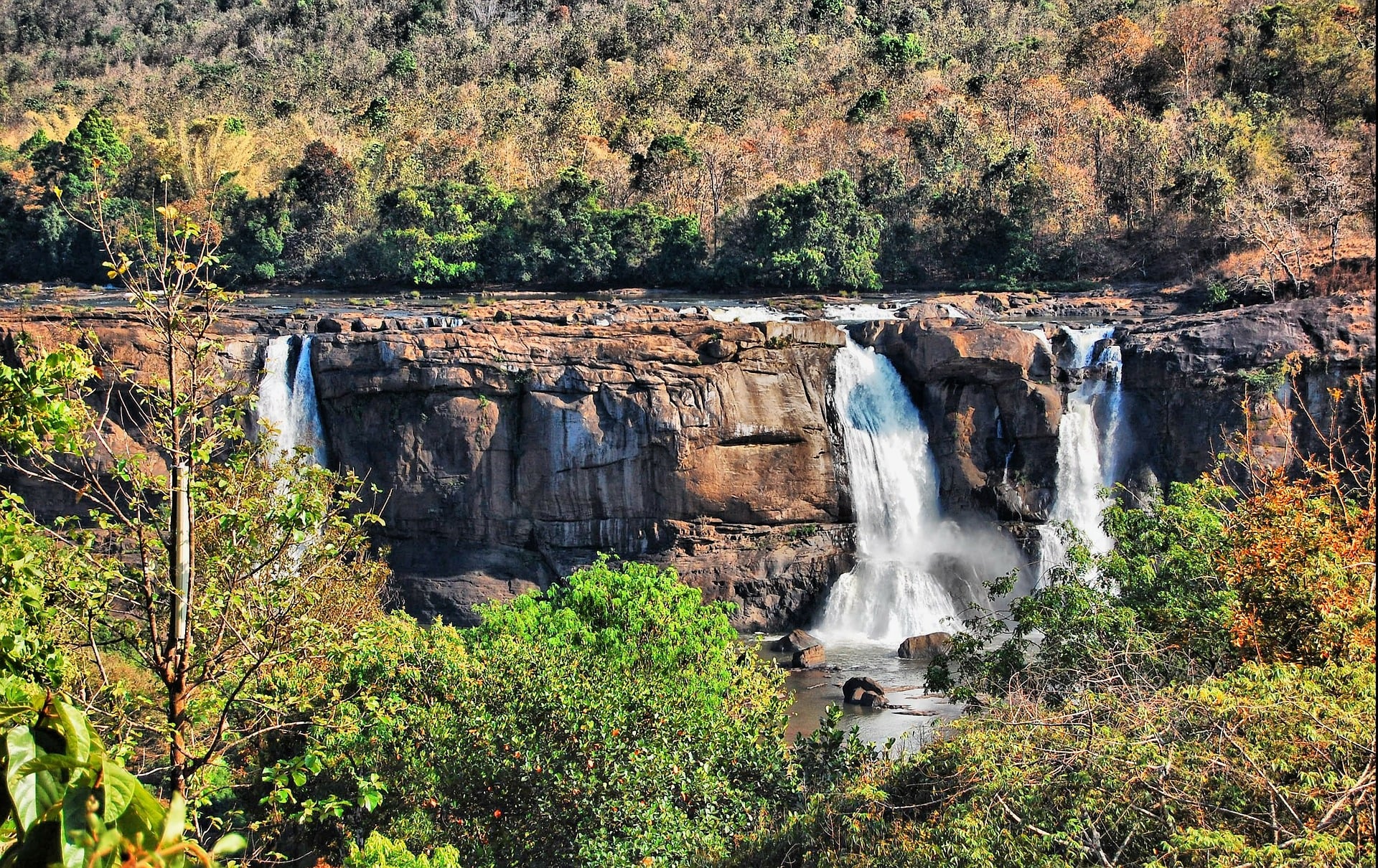
| WAYANAD
Wayanad and its nature reserve offer the chance to immerse yourself in nature at an altitude of between 700 and 2,000 metres, and to go in search of the animals that inhabit its mountains. It’s a green paradise of over 20,000 hectares of forest, covered with eucalyptus, teak and coffee plantations, but it’s also the world’s largest concentration of Asian elephants. In the foothills of the Ghats lies the Wildlife Sanctuary little visited by travelers but much appreciated by Indians. The reserve can be explored by 4×4, but as the park was closed in March 2015, we visited it with our driver in our car as we walked around the outside of it. We might have been lucky enough to see the lion-headed macaques inside, although the chances of sightings are difficult as they live in the canopy of rainforests up to 1,800 meters above sea level.
Avoid walking alone in the wild in this region. In February 2015, a man was killed and eaten by one of the 14 wild tigers still at large in this open reserve. For our part, we saw several wild elephants crossing the roads and villages, fallow deer, wild dogs (a cross between a fox and a dog) and peacocks. It’s a real favorite. We recommend that you use reserve Tholpetty to Muthanga’s, as you have a better chance of spotting animals in season.
In Wayanad, we stayed in this very peaceful place in the countryside, where it’s good to stop for a few days to rest. This homestay is surrounded by rice paddies, lush vegetation and a huge tropical garden with passion fruit, pineapples, bananas… Here we took the opportunity to explore the wildlife on a night safari: snakes and pretty frogs were the order of the day.
But what are the Ghats? named after the English word for “keeping the place”, ghats stop the air and bring in the rain. The Ghats lie between the plains and the mountains, from Goa to Munnar! In short, the Ghats protect Kerala by giving rain.
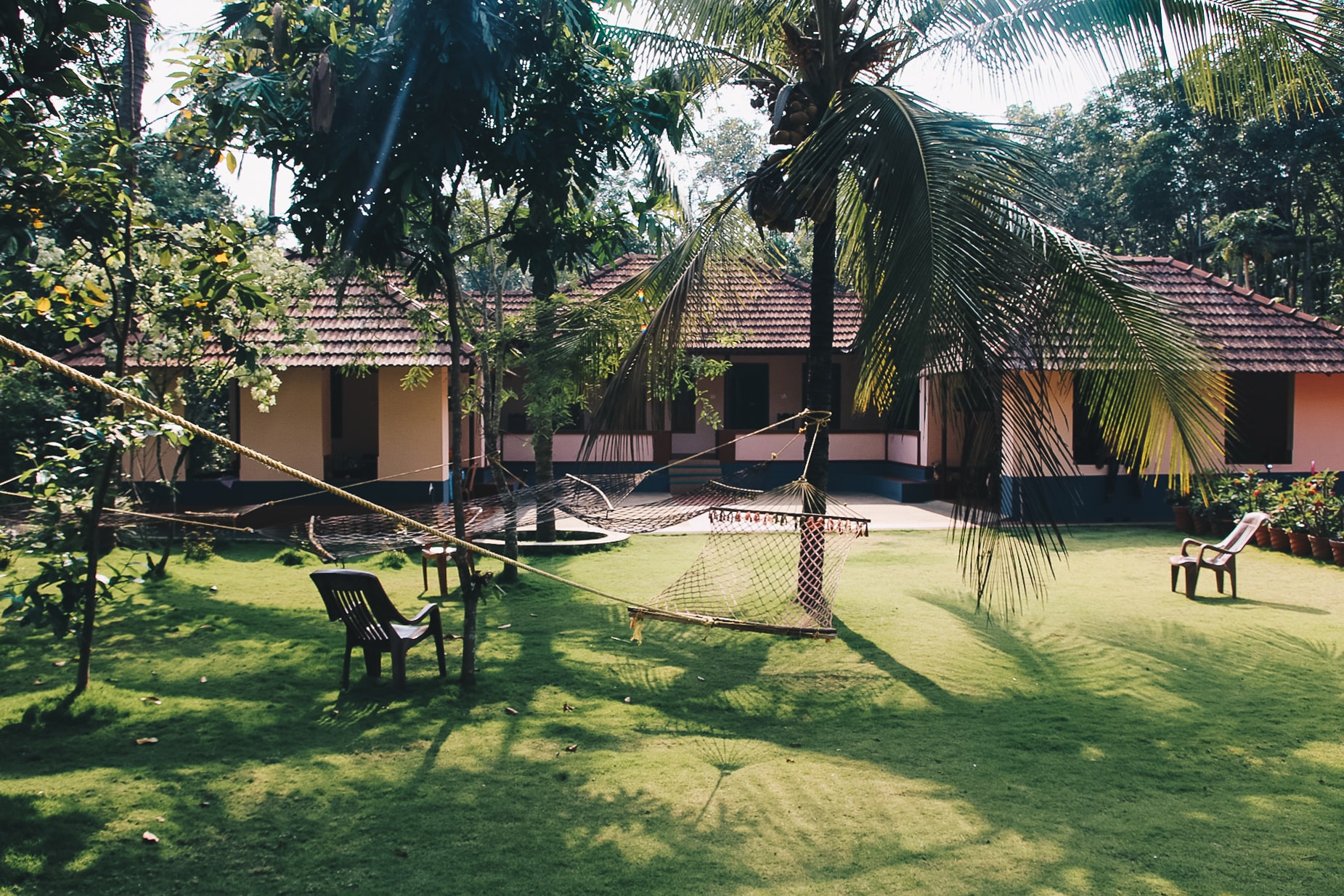
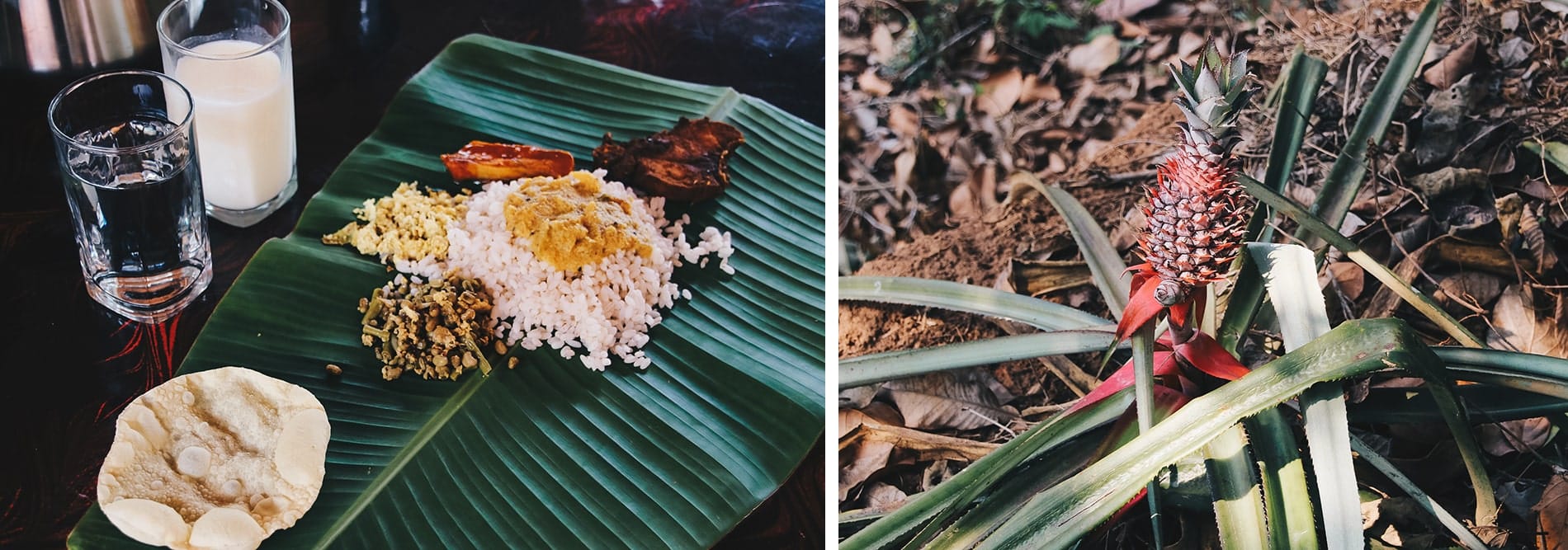
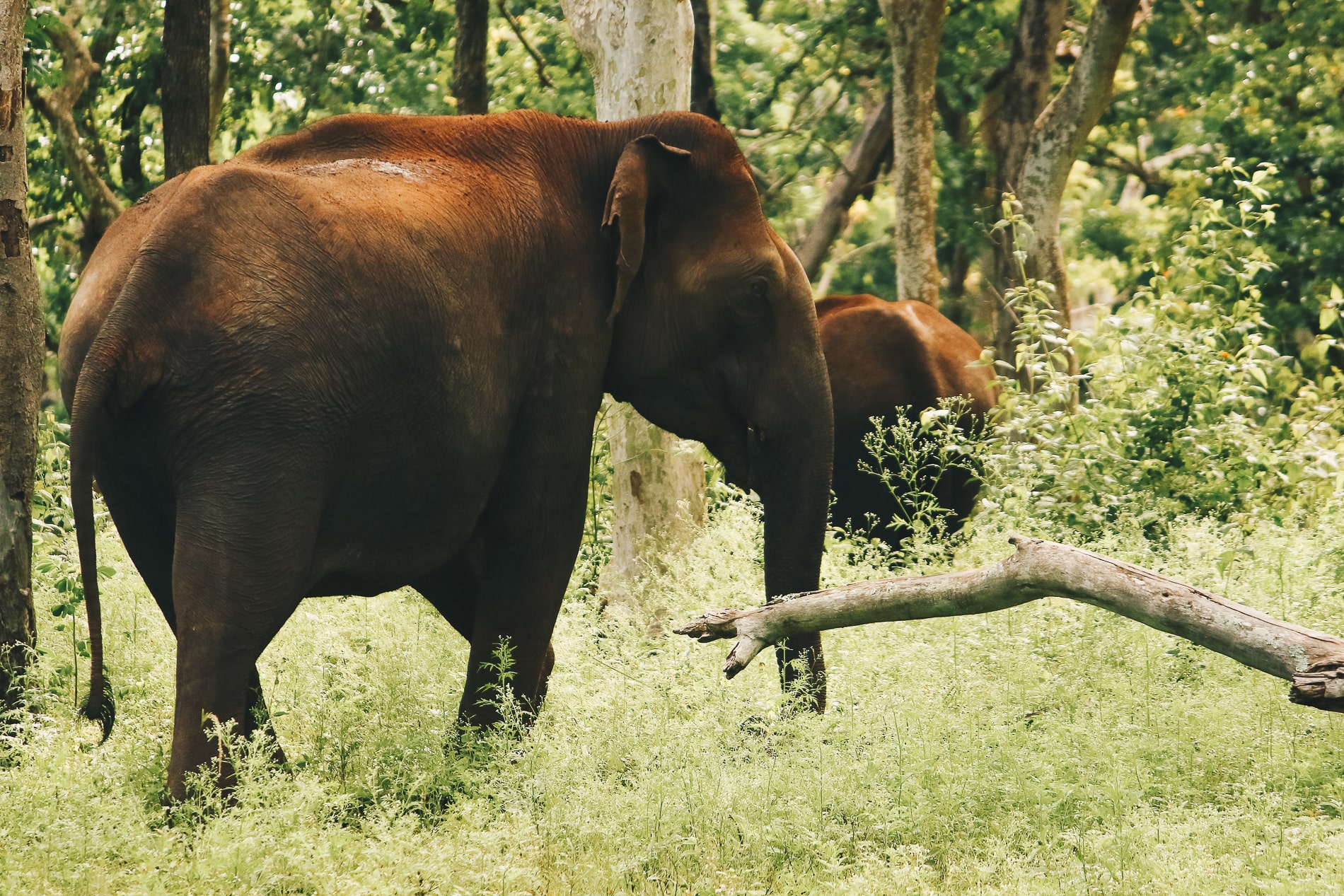
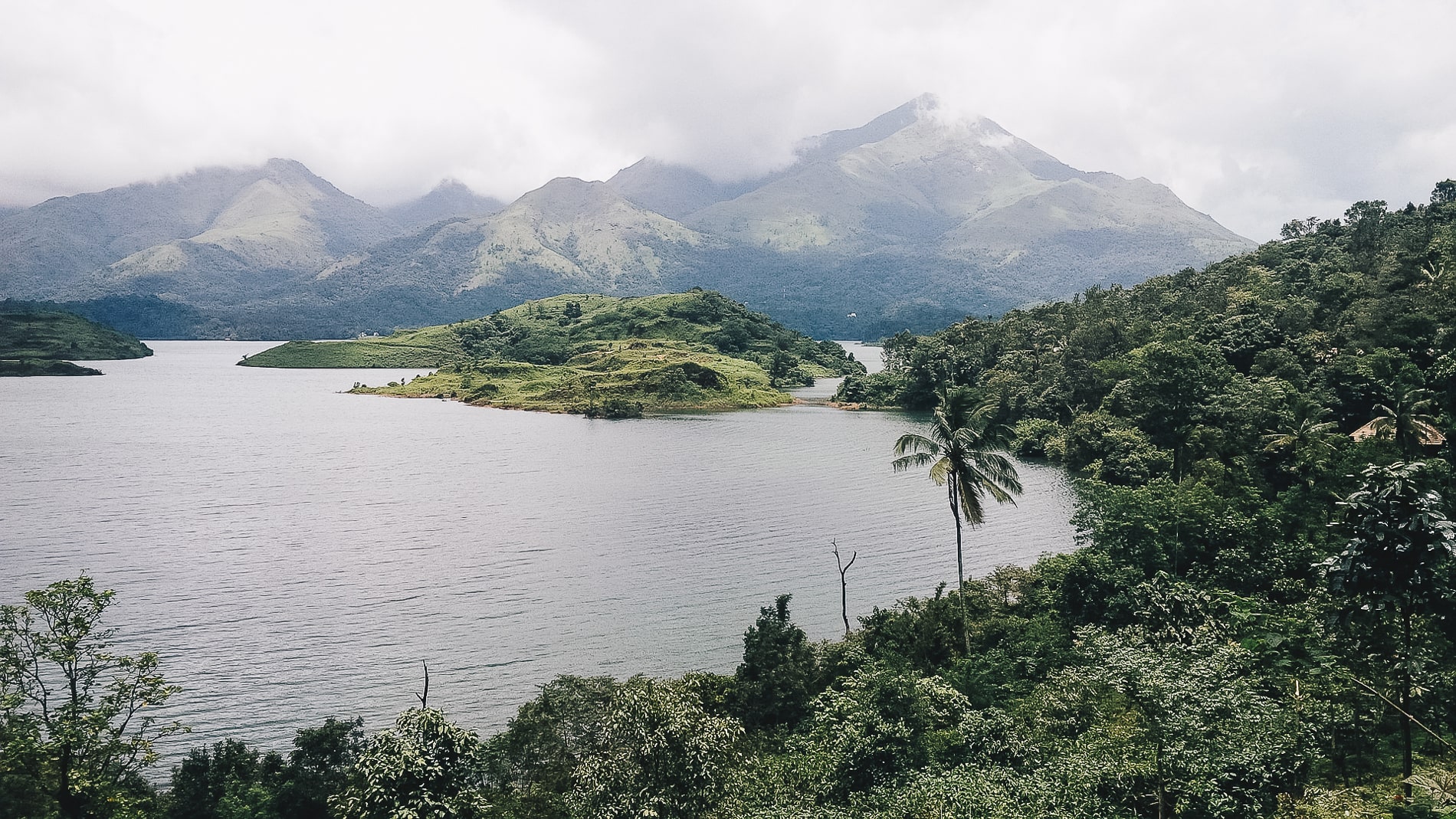
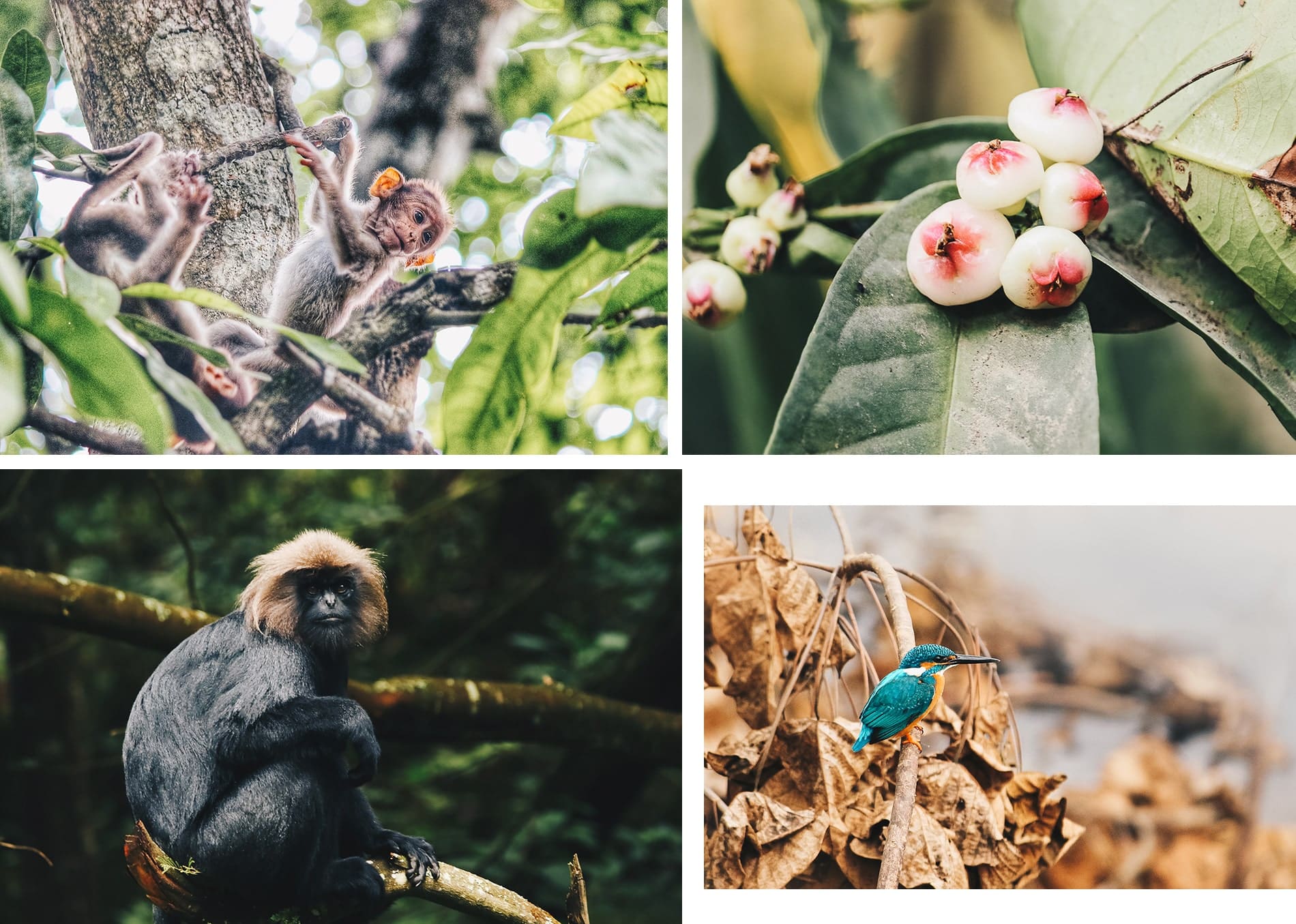
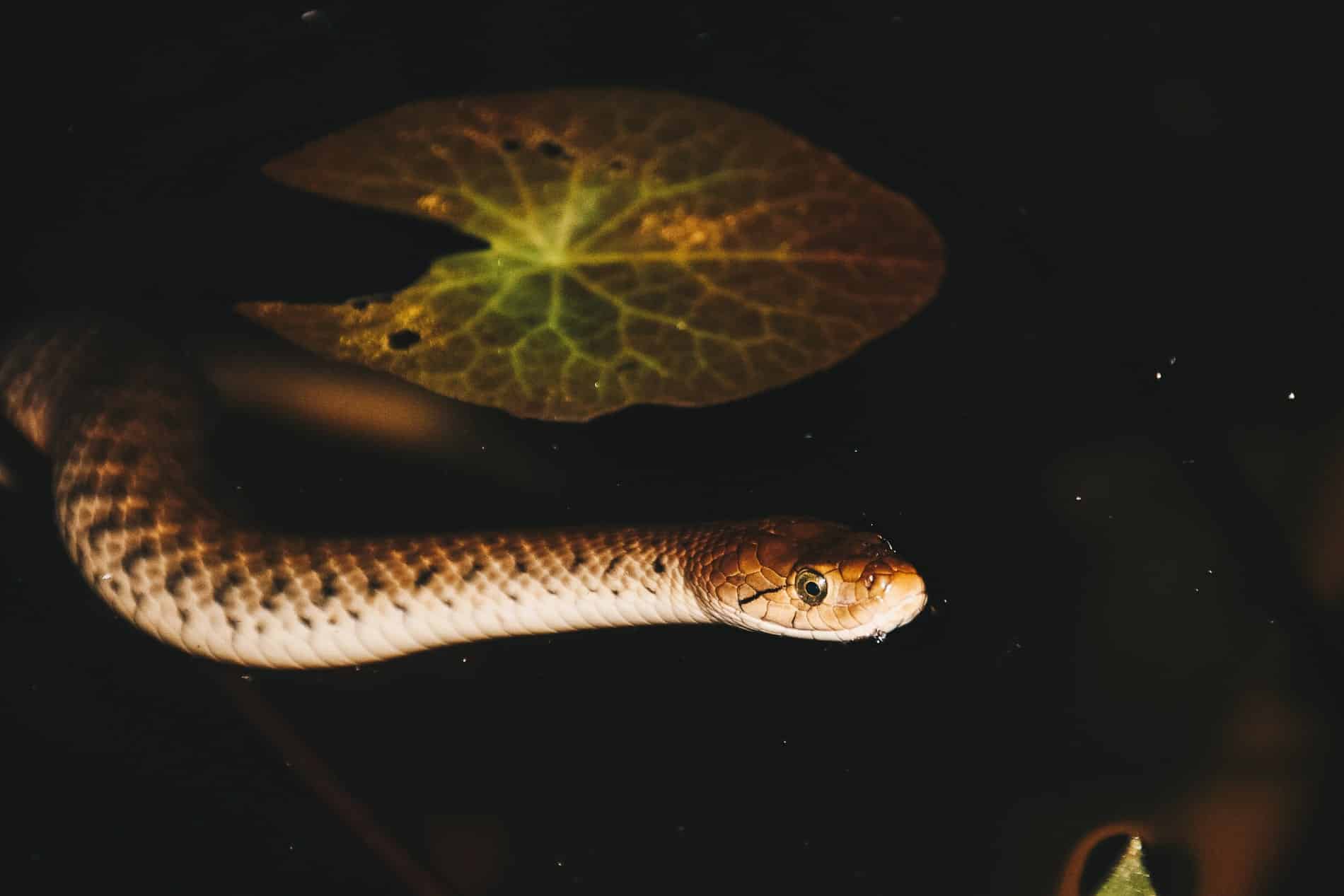
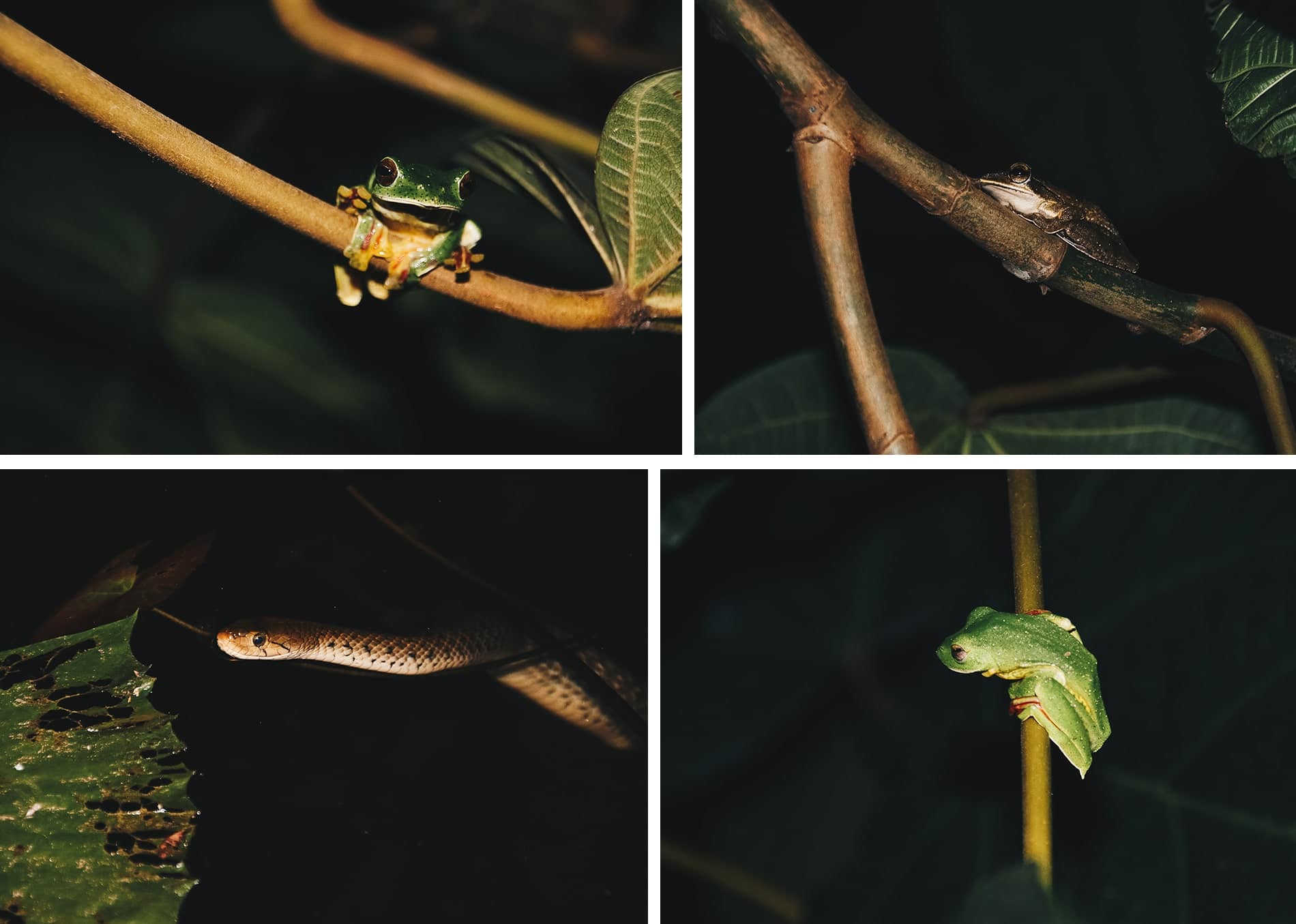
| MYSORE
Last stop on our journey, Mysore, Karnataka’s southernmost city. It is close to the states of Kerala and Tamil Nadu to the south. The town is famous for its silk and sandalwood, in the form of incense and soap. On the program, a visit to the temple of Somnathpur is about an hour’s drive from Mysore and is dedicated to the god Vishnu. It is built on a star-shaped stele and adorned with numerous well-crafted sculptures.
Then on to the Mysore market “Devaraja Market” which is big enough. The market atmosphere is at its best, with merchants shouting from their stalls to lure customers in: colors, scents, stalls of vegetables and flowers (especially the jasmine that perfumes the place) are the order of the day. Finally, we visited the Palais of the Maharaja of Mysore, which we found rather empty and overcrowded, but after spending 21 days in the Rajasthan, maybe we’d had our fill of palace! The main attraction of this palace is the view outside, which is magnified on Saturdays and Sundays from 7pm to 8pm by outdoor lighting illuminating the palace.
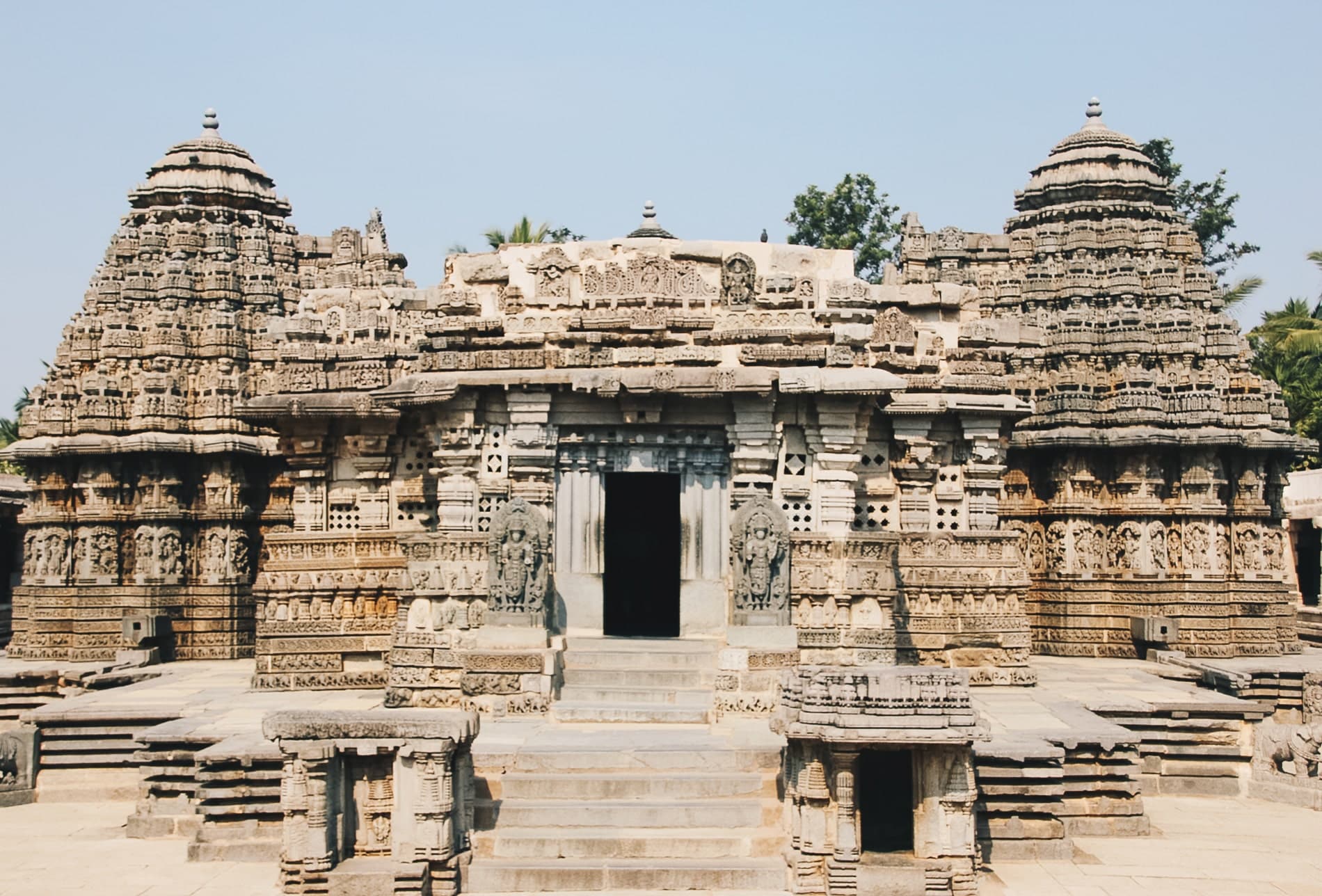
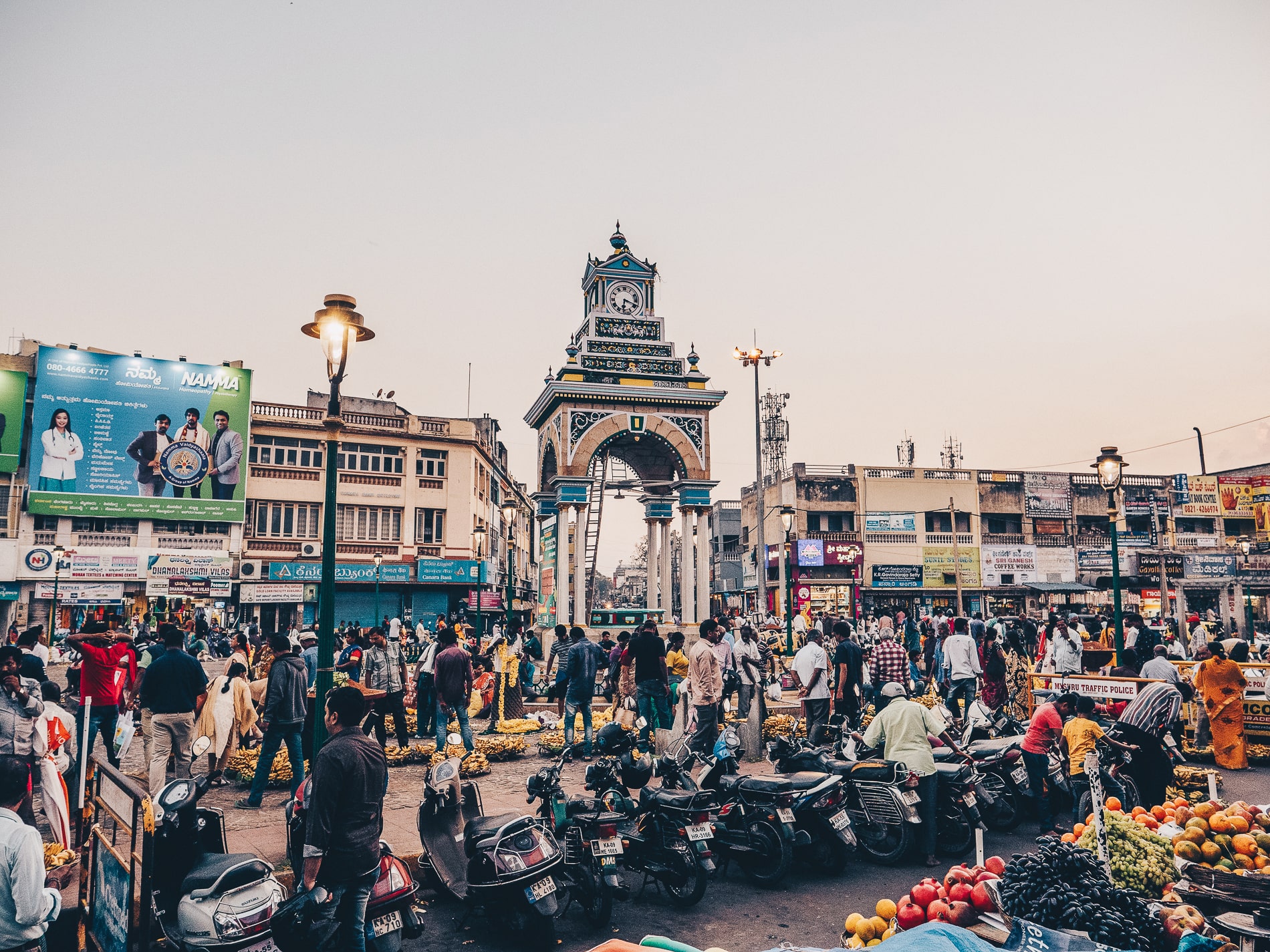
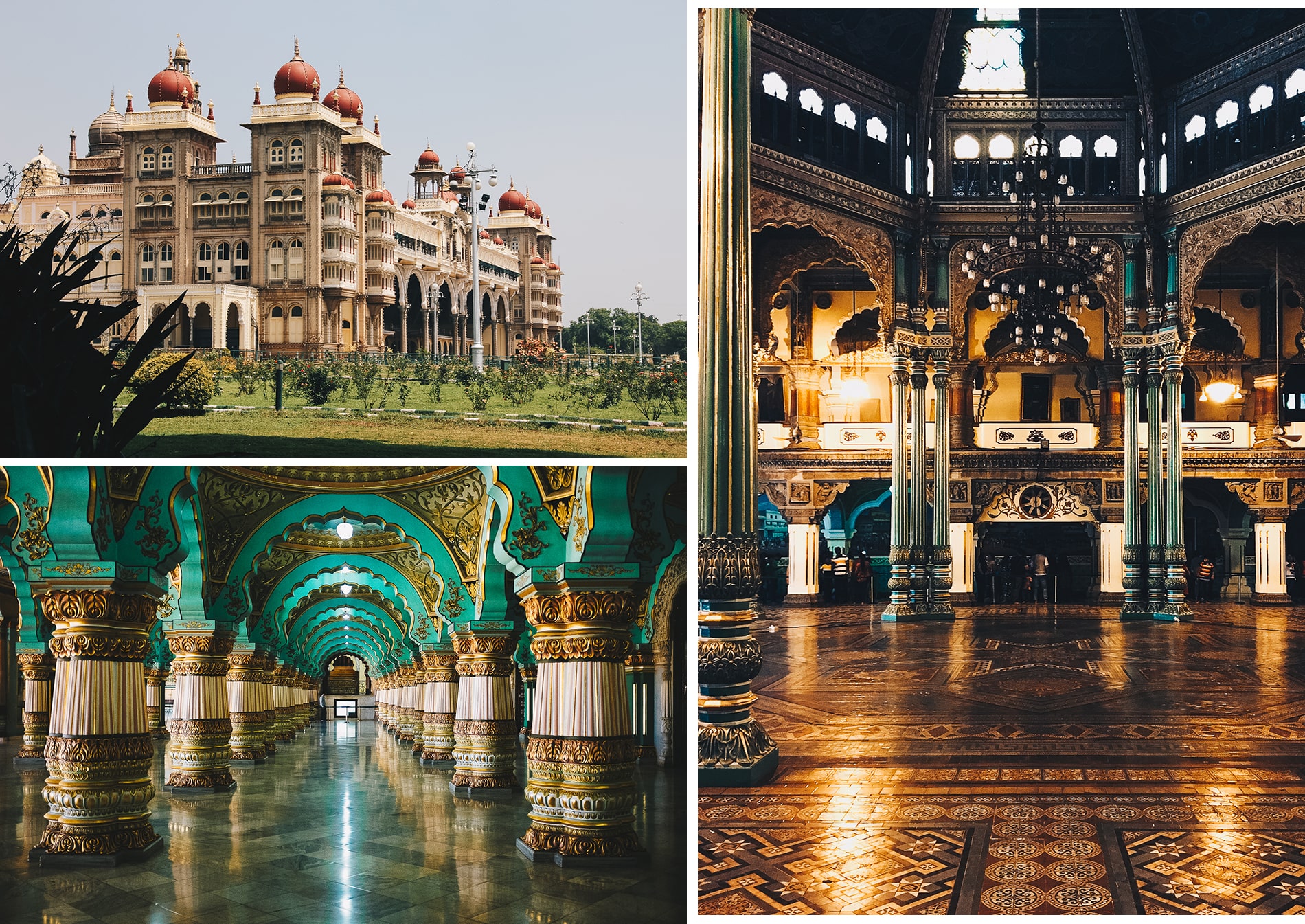
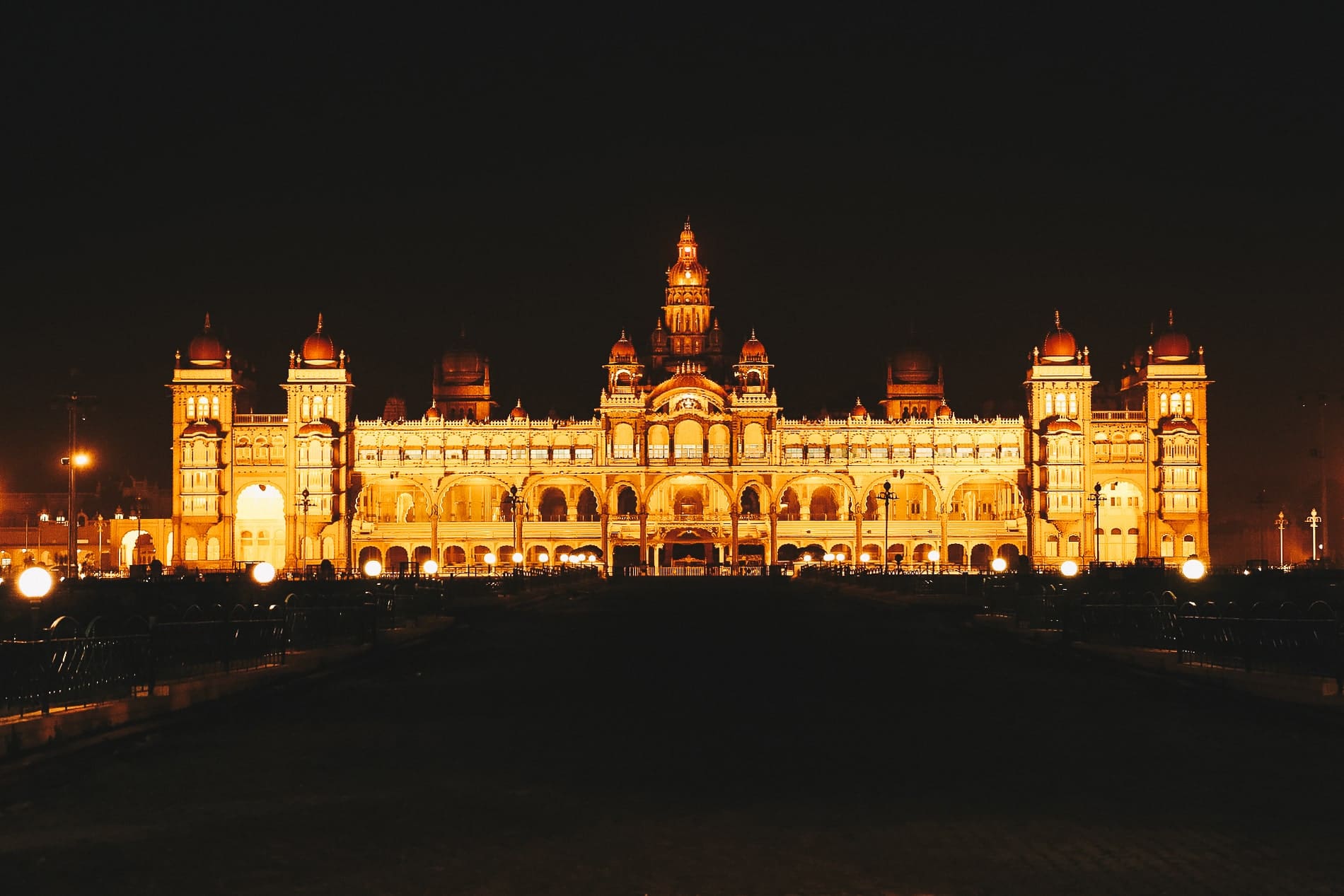
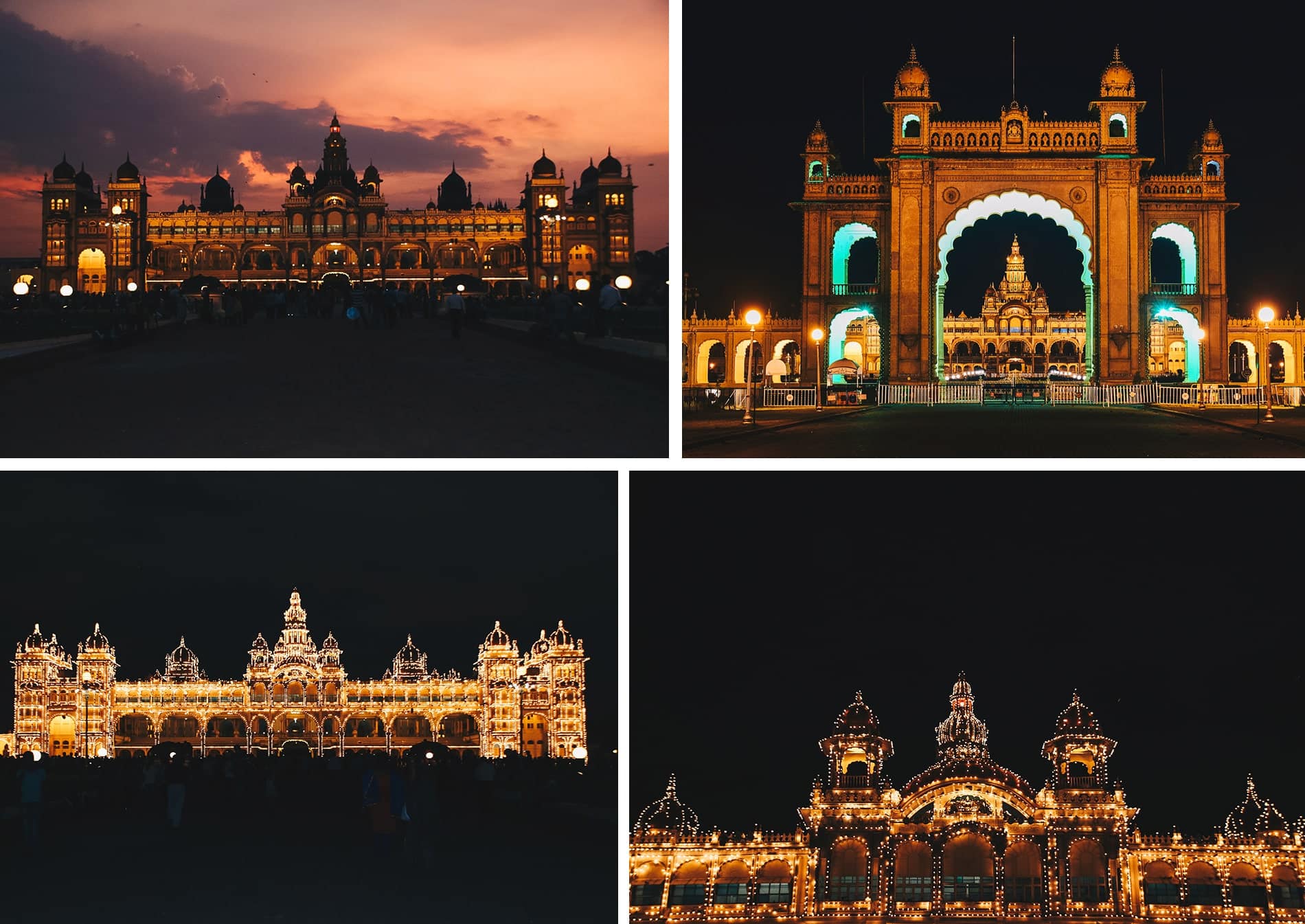
Our stay in Kerala was an incredible journey to discover a region in a class of its own, where exuberant nature, spices, landscapes and people have left a deep impression on us. Kerala is a cultural, relaxing and exotic destination, a real favorite that’s nothing like Rajasthan. Kerala is also an opportunity to try the Ayurvedic treatments that have been healing people for millennia, and to be introduced to yoga in sumptuous settings.
South India also offers a wide range of activities such as trekking, paragliding, safaris, boat trips, kayaking, rafting…
It’s a completely different country here and we hope this itinerary has inspired you to travel to India.
Before you leave, don’t forget to read all our other articles on Kerala to help you prepare for your trip:
- How to soothe your body with ayurveda
- Our tasty and spicy Indian recipes
- The 9 spices of Indian cuisine
- The practical guide to planning your trip
Please note that, as an accredited tailor-made travel designer, I can help you create your own personalized itinerary for your stay in India. Please send me an email at : contact@mademoiselle-voyage.fr

